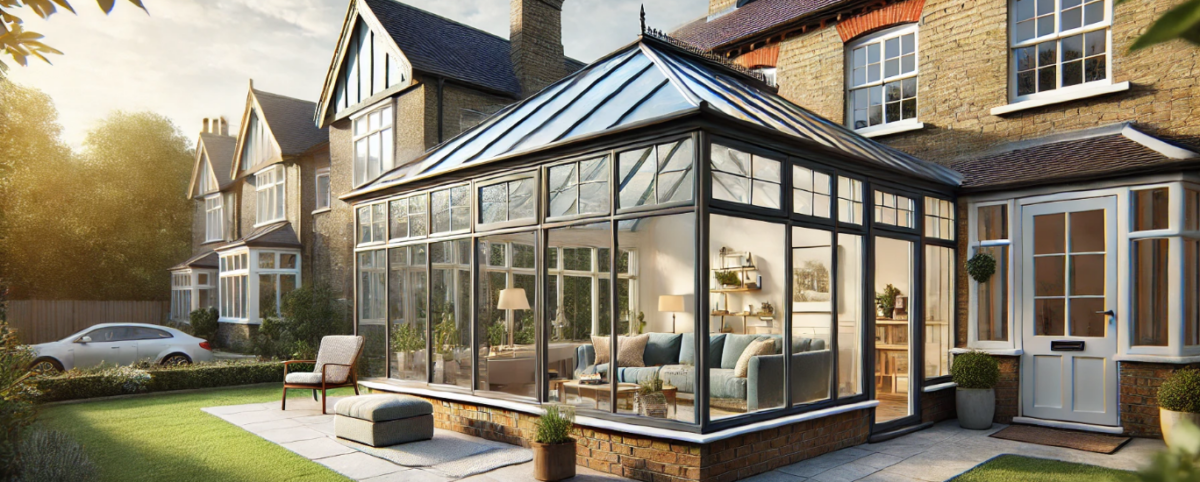September 30, 2024
If you’re looking to add some extra space and value to your property, a conservatory is often cheaper than building an extension. But how much does it cost to build a conservatory in the UK?
In this article, we’ve covered the costs of building three types of conservatories across multiple regions in the UK, and we’ve also provided a breakdown of the construction costs by stage as well as the costs per square metre.
Start your free trial with BuildPartner today to get the most accurate estimate of building a conservatory based on your own dimensions and specifications.
Conservatory Cost Considerations
Our calculations are based on a 4 x 3m conservatory (12m2). The three main types of conservatory covered in this article include:
- Conservatory with a reinforced glass roof.
- Conservatory with slate roof tiles – including roof structure, insulation, plasterboard, decoration, light fittings, etc.
- Orangery with glass roof – including brick wall, cavity insulation, plasterboard, decoration, etc.
The costs do not include additional heating, such as radiators or underfloor heating.
Build Specifications and Supplier Benchmarks
In terms of build specification, our BuildPartner pricing tool gives you three options (which can be revised by item at a later point):
- Basic spec is a basic finish; e.g. Leyland, Everest, Wickes.
- Standard spec is a standard finish; e.g. Dulux, Hamilton, Slim Line.
- Premium spec is a high-spec finish; e.g. Farrow & Ball, Fine Line, Siemens.
For this particular cost breakdown, we have selected standard spec. In addition, for each specification, we’ve provided a range of prices to reflect the varying types of contractors:
- Low benchmark – smaller companies are generally lower cost but less specialised and with low project management function; good for low/mid-spec projects and tight budgets.
- Mid benchmark – medium-sized companies offer a balanced mix of cost-effectiveness and specialisation; good for mid-range projects for effective execution within moderate budgets.
- High benchmark – larger companies generally have a higher cost base but can handle a wide variety of specialist tasks; good for mid/high-spec projects and project management.
Cost Of Building A Glass Roof Conservatory
Here’s a table showing the average cost of building a conservatory for a standard-spec project in the UK:
| Conservatory – Structural Glass Roof | Total Average Build Cost | Average Cost Per Sq Metre | ||||
| Low Benchmark | Mid Benchmark | High Benchmark | Low Benchmark | Mid Benchmark | High Benchmark | |
| East Anglia | £32,707 | £35,680 | £38,653 | £2,726 | £2,973 | £3,221 |
| London | £34,690 | £38,790 | £42,574 | £2,891 | £3,232 | £3,548 |
| Midlands | £32,404 | £35,350 | £38,295 | £2,700 | £2,946 | £3,191 |
| North England | £32,150 | £35,203 | £38,136 | £2,679 | £2,934 | £3,178 |
| Northern Ireland | £31,974 | £34,660 | £37,548 | £2,648 | £2,888 | £3,129 |
| Scotland | £32,175 | £35,101 | £38,026 | £2,681 | £2,925 | £3,169 |
| South East | £31,915 | £35,686 | £39,594 | £2,891 | £3,232 | £3,548 |
| South West | £32,557 | £36,572 | £40,140 | £2,726 | £3,048 | £3,345 |
| Wales | £32,407 | £36,236 | £38,531 | £2,701 | £3,020 | £3,211 |
| Average | £32,553 | £35,920 | £39,055 | £2,738 | £3,022 | £3,282 |
All costs exclude VAT.
Here’s what the data shows for the cost of building a glass roof conservatory to a standard spec:
- The minimum cost is £31,915, and the maximum cost is £42,574.
- The total average cost is £35,843, or £3,014 per square metre.
Building Cost Breakdown By Project Stage – London
Here’s an example of the associated costs for the different stages of building a glass roof conservatory for a standard-spec project – when using a mid-benchmark contractor in London:
| Total | £38,790 | 100% |
| Roof structure and coverings | £17,174 | 44.3% |
| External windows and doors | £9,945 | 25.6% |
| Preliminaries | £5,302 | 13.7% |
| Foundations and substructure | £3,342 | 8.6% |
| Floor structure and lining | £1,581 | 4.1% |
| Drainage and pipework | £693 | 1.8% |
| Demolitions | £310 | 0.8% |
| External wall structure and lining | £225 | 0.6% |
| Wiring and fuseboards | £218 | 0.6% |
The cost of the roof structure for a reinforced glass roof is much higher when compared to a standard roof structure with slate tiles – due mainly to the high cost of reinforced glass.
Cost Of Building A Tiled Roof Conservatory
Here’s a table showing the average cost of building a tiled roof conservatory for a standard-spec project in the UK:
| Conservatory – Slate Roof Tiles | Total Average Build Cost | Average Cost Per Sq Metre | ||||
| Low Benchmark | Mid Benchmark | High Benchmark | Low Benchmark | Mid Benchmark | High Benchmark | |
| East Anglia | £19,709 | £21,500 | £23,292 | £1,642 | £1,792 | £1,941 |
| London | £21,750 | £24,321 | £26,693 | £1,813 | £2,027 | £2,224 |
| Midlands | £19,399 | £21,162 | £22,926 | £1,617 | £1,764 | £1,910 |
| North England | £19,142 | £21,012 | £22,763 | £1,595 | £1,751 | £1,897 |
| Northern Ireland | £18,957 | £20,456 | £22,160 | £1,563 | £1,705 | £1,847 |
| Scotland | £19,164 | £20,906 | £22,648 | £1,597 | £1,742 | £1,887 |
| South East | £20,010 | £22,375 | £24,558 | £1,813 | £2,027 | £2,224 |
| South West | £19,555 | £22,038 | £24,188 | £1,642 | £1,836 | £2,016 |
| Wales | £19,402 | £21,694 | £23,167 | £1,617 | £1,808 | £1,931 |
| Average | £19,676 | £21,718 | £23,599 | £1,655 | £1,828 | £1,986 |
All costs exclude VAT.
Here’s what the data shows for the cost of building a tiled roof conservatory to a standard spec:
- The minimum cost is £18,957, and the maximum cost is £26,693.
- The total average cost is £21,665, or £1,823 per square metre.
Building Cost Breakdown By Project Stage – London
Here’s an example of the associated costs for the different stages of building a tiled roof conservatory for a standard-spec project – when using a mid-benchmark contractor in London:
| Total | £24,321 | 100% |
| External windows and doors | £9,945 | 40.9% |
| Preliminaries | £5,302 | 21.8% |
| Foundations and substructure | £3,342 | 13.7% |
| Roof structure and coverings | £2,242 | 9.2% |
| Floor structure and lining | £1,581 | 6.5% |
| Drainage and pipework | £693 | 2.8% |
| Ceiling structure and lining | £464 | 1.9% |
| Demolitions | £310 | 1.3% |
| External wall structure and lining | £225 | 0.9% |
| Wiring and fuseboards | £218 | 0.9% |
Cost Of Building An Orangery
Here’s a table showing the average cost of building an orangery for a standard-spec project in the UK:
| Orangery – Structural Glass Roof | Total Average Build Cost | Average Cost Per Sq Metre | ||||
| Low Benchmark | Mid Benchmark | High Benchmark | Low Benchmark | Mid Benchmark | High Benchmark | |
| East Anglia | £35,866 | £39,126 | £42,387 | £2,989 | £3,261 | £3,532 |
| London | £38,473 | £43,020 | £47,217 | £3,206 | £3,585 | £3,935 |
| Midlands | £35,483 | £38,709 | £41,934 | £2,957 | £3,226 | £3,495 |
| North England | £35,194 | £38,523 | £41,734 | £2,933 | £3,210 | £3,478 |
| Northern Ireland | £34,490 | £37,753 | £40,899 | £2,874 | £3,146 | £3,408 |
| Scotland | £35,175 | £38,373 | £41,571 | £2,931 | £3,198 | £3,464 |
| South East | £35,396 | £39,579 | £43,912 | £2,950 | £3,298 | £3,659 |
| South West | £35,676 | £40,104 | £44,017 | £2,973 | £3,342 | £3,668 |
| Wales | £35,486 | £39,679 | £42,234 | £2,957 | £3,307 | £3,519 |
| Average | £35,693 | £39,430 | £42,878 | £2,974 | £3,286 | £3,573 |
All costs exclude VAT.
Here’s what the data shows for the cost of building an orangery to a standard spec:
- The minimum cost is £34,490, and the maximum cost is £47,217.
- The total average cost is £39,334, or £3,278 per square metre.
Building Cost Breakdown By Project Stage – London
Here’s an example of the associated costs for the different stages of building an orangery for a standard-spec project – when using a mid-benchmark contractor in London:
| Total | £43,020 | 100% |
| Roof structure and coverings | £17,174 | 39.9% |
| External windows and doors | £9,945 | 23.1% |
| Preliminaries | £5,487 | 12.8% |
| External wall structure and lining | £3,785 | 8.8% |
| Foundations and substructure | £3,342 | 7.8% |
| Floor structure and lining | £1,581 | 3.7% |
| Drainage and pipework | £693 | 1.6% |
| Decoration | £486 | 1.1% |
| Demolitions | £310 | 0.7% |
| Wiring and fuseboards | £218 | 0.5% |
Summary Of The Average Cost To Build A Conservatory
So, how much does it cost to build a conservatory in the UK? Based on the two types covered in this article, you can expect it to cost on average (when using a mid-benchmark contractor):
- Conservatory with structural glass roof – £35,920, or £3,022 per sq metre.
- Conservatory with slate roof tiles – £21,718, or £1,828 per sq metre.
- Orangery with structural glass roof – £39,430, or £3,286 per sq metre.
Depending on the specifications, the cost of the work for a conservatory build would range between £18,957 and £47,217.
Please remember that these costs do not include VAT, and there may be other additional costs, such as obtaining planning permission, conducting structural surveys, making unexpected repairs, and completing custom finishes.
Start your free trial with BuildPartner today to get the most accurate estimate of building a conservatory based on your own dimensions and specifications.
Frequently Asked Questions About Conservatories
Here are a few questions about building conservatories in the UK.
What’s the difference between a conservatory and an orangery?
An orangery is fundamentally a brick structure with large glass windows and roofing, which provides more insulation than a fully glazed conservatory.
How can I make a conservatory more energy-efficient?
To make a conservatory more energy efficient, use triple glazing, install a tiled roof, and consider underfloor heating or energy-efficient radiators. Using blinds also regulates temperature.
Do I need planning permission for a conservatory?
Planning permission is generally not required for a conservatory if it meets permitted development rights. Your conservatory must be at the rear of the house, less than four metres high, less than 50% of the area of the land around the house, and its walls must run within the length of the property’s walls.

August 28, 2024
Renovating a flat in the UK requires careful cost planning and budgeting. In this 2024 guide, we provide a comprehensive cost breakdown of a 1-bedroom and 2-bedroom flat, and we also break the cost down per square metre.
Whether you’re undertaking a full-scale refurbishment or focusing on specific areas like the kitchen or bathroom, this guide furnishes you with the insights needed to navigate your renovation project.
Key Factors Affecting Flat Renovation Costs
When renovating a flat, several key factors come into play that significantly impact the overall cost. Firstly, the median floor space of the average UK flat is 58m2, so our calculations are based on a 2-bedroom flat of 64m2 and a 1-bedroom flat of 52m2, with both comprising an open-plan kitchen and living room and a bathroom.
Our cost breakdown includes all appliances, such as a built-in dishwasher, fridge, freezer, washing machine, extractor fan, hob, and oven. The only exclusion is a central heating boiler; however, radiators are included.
It’s also important to distinguish between a renovation and a remodel. A renovation focuses exclusively on replacing the finishings and fittings in their existing locations and does not involve changing the layout of a structure.
Build Specifications & Supplier Benchmarks
In terms of build specifications, our BuildPartner pricing tool gives you three options when creating your quote (which can be revised by item at a later point):
- Basic spec is a basic finish; e.g., Leyland, Everest, Wickes.
- Standard spec is a standard finish; e.g., Dulux, Hamilton, Slim Line.
- Premium spec is a high-spec finish; e.g., Farrow & Ball, Fine Line, Siemens.
For each renovation type (1-bed and 2-bed flat), we’ve provided a range of prices to reflect the varying types of contractors:
- Low benchmark – smaller companies are generally lower cost but less specialised and with low project management function; good for low/mid-spec projects and tight budgets.
- Mid benchmark – medium-sized companies offer a balanced mix of cost-effectiveness and specialisation; good for mid-range projects for effective execution within moderate budgets.
- High benchmark – larger companies generally have a higher cost base but can handle a wide variety of specialist tasks; good for mid/high-spec projects and project management.
Cost Of A 2-Bedroom Flat Renovation
Here’s a table showing the average building costs of renovating a 2-bed flat for a standard-spec project in the UK:
| 2-Bedroom Flat Refurb | Total Average Build Cost | Average Cost Per Sq Metre | ||||
| Low Benchmark | Mid Benchmark | High Benchmark | Low Benchmark | Mid Benchmark | High Benchmark | |
| East Anglia | £33,602 | £36,657 | £39,711 | £525 | £573 | £620 |
| London | £37,306 | £42,268 | £46,413 | £583 | £660 | £725 |
| Midlands | £32,998 | £35,998 | £38,998 | £516 | £562 | £609 |
| North England | £32,864 | £35,852 | £38,840 | £514 | £560 | £607 |
| Northern Ireland | £32,410 | £34,781 | £37,680 | £498 | £543 | £589 |
| Scotland | £32,937 | £35,931 | £38,925 | £515 | £561 | £608 |
| South East | £34,321 | £38,377 | £42,579 | £583 | £652 | £715 |
| South West | £33,329 | £37,573 | £41,239 | £525 | £587 | £644 |
| Wales | £33,056 | £36,962 | £39,520 | £516 | £578 | £618 |
| Average | £33,647 | £37,156 | £40,434 | £530 | £586 | £637 |
All costs exclude VAT.
Here’s what the data shows for the cost of fully renovating a 2-bed flat to a standard spec:
- It costs 15% more to renovate a 2-bed flat in London than in other regions.
- The minimum cost is £32,410, and the maximum cost is £46,413.
- The total average cost is £37,079, or £585 per square metre.
2-Bed Flat Renovation Cost Breakdown – London
Here’s an example of the associated costs for the different stages of a renovation for a standard-spec project – when using a mid-benchmark contractor in London:
| Total | £42,268 | 100.0% |
| Demolitions | £1,464 | 3.5% |
| Heating and cooling | £1,384 | 3.3% |
| Plumbed appliances | £3,916 | 9.3% |
| Wired appliances | £4,932 | 11.7% |
| Ceiling preparation and finishes | £549 | 1.2% |
| Wall preparation and finishes | £3,797 | 9.0% |
| Floor preparation and finishes | £9,274 | 21.9% |
| Units, worktops and kitchen appliances | £16,528 | 39.1% |
| Fixtures and fittings | £425 | 1.0% |
And here’s a breakdown of the associated costs by room for a standard-spec renovation project – when using a mid-benchmark contractor in London:
| Total | £42,268 | 100% |
| Bathroom | £9,836 | 23.3% |
| Bedroom 1 | £4,332 | 10.2% |
| Bedroom 2 | £3,795 | 9.0% |
| Kitchen / Living / Dining | £24,306 | 57.5% |
Remember, appliances are included in the costs, which is why the kitchen accounts for a disproportionate amount of the total expense.
Cost Of A 1-Bedroom Flat Renovation
Here’s a table showing the average building costs of fully renovating a 1-bed flat for a standard-spec project in the UK:
| 1-Bedroom Flat Refurb | Total Average Build Cost | Average Cost Per Sq Metre | ||||
| Low Benchmark | Mid Benchmark | High Benchmark | Low Benchmark | Mid Benchmark | High Benchmark | |
| East Anglia | £30,685 | £33,475 | £36,264 | £590 | £644 | £697 |
| London | £33,912 | £38,474 | £42,248 | £652 | £740 | £812 |
| Midlands | £30,184 | £32,928 | £35,672 | £580 | £633 | £686 |
| North England | £30,068 | £32,801 | £35,535 | £578 | £631 | £683 |
| Northern Ireland | £29,675 | £31,890 | £34,548 | £562 | £613 | £664 |
| Scotland | £30,118 | £32,855 | £35,593 | £579 | £632 | £684 |
| South East | £31,199 | £34,886 | £38,290 | £652 | £729 | £800 |
| South West | £30,455 | £34,311 | £37,659 | £590 | £660 | £724 |
| Wales | £30,226 | £33,798 | £36,108 | £581 | £650 | £694 |
| Average | £30,725 | £33,935 | £36,880 | £596 | £659 | £716 |
All costs exclude VAT.
Here’s what the data shows for the cost of fully renovating a 1-bed flat to a standard spec:
- The minimum cost is £29,675, and the maximum cost is £42,248.
- The total average cost is £33,847, or £657 per square metre.
1-Bed Flat Renovation Cost Breakdown – London
Here’s an example of the associated costs for the different stages of a renovation for a standard-spec project – when using a mid-benchmark contractor in London:
| Total | £36,304 | 100.0% |
| Demolitions | £944 | 2.6% |
| Heating and cooling | £789 | 2.2% |
| Plumbed appliances | £3,711 | 10.2% |
| Wired appliances | £3,278 | 9.0% |
| Ceiling preparation and finishes | £371 | 1.0% |
| Wall preparation and finishes | £3,307 | 9.1% |
| Floor preparation and finishes | £7,673 | 21.1% |
| Units, worktops and kitchen appliances | £15,810 | 43.5% |
| Fixtures and fittings | £422 | 1.2% |
And here’s a breakdown of the associated costs by room for a standard-spec renovation project – when using a mid-benchmark contractor in London:
| Total | £36,304 | 100% |
| Bathroom | £9,147 | 25.2% |
| Bedroom | £4,088 | 11.3% |
| Kitchen / Living / Dining | £23,070 | 63.5% |
Summary Of The Average Cost To Renovate A Flat In The UK
So, how much does a flat renovation cost in the UK? Based on the three different types of contractors, renovating a 2-bedroom flat (64m2) will cost you on average:
- Low benchmark contactor – £33,647, or £530 per sq metre.
- Mid-benchmark contactor – £37,156, or £586 per sq metre.
- High-benchmark contractor – £40,434, or £637 per sq metre.
Depending on the specifications, the cost of the renovation work will typically range between £32,410 and £46,413 for a 2-bedroom flat.
Please remember that these costs do not include VAT, and there may be other additional costs, such as structural surveys, unexpected repairs, and custom finishes.
Frequently Asked Questions About Flat Renovations
Here are a few questions that shed some light on UK flat renovations.
How long does a flat renovation take?
Based on a 2-bedroom flat comprising an open-plan kitchen-living room and a bathroom, a renovation would take approximately four weeks.
This is based on two tradespeople carrying out the scheduled work (demolitions, heating and cooling, wall preparation, floor preparation, plumbed and wired appliances, kitchen units, decoration, and fixtures and fittings).

What is the most common pitfall when renovating a flat?
Since many flats are leasehold, they tend to have strict rules governing when noisy work can take place, often restricting it to specific hours on weekdays and prohibiting it altogether on weekends or evenings. It’s better to adhere to these to avoid potential conflicts and complaints.
Do I have to let my neighbour know before starting work?
If your renovation affects a shared or adjoining wall, you must notify your neighbour under the Party Wall Act 1996. A Party Wall Notice should be given at least two months before major work begins. Your neighbour then has 14 days to consent or request a Party Wall Agreement. Failing to notify them can lead to legal issues and project delays.
Do I need planning permission for a flat renovation?
Most internal renovations do not require planning permission, but you may need approval if you’re making structural changes, especially in listed buildings or conservation areas.
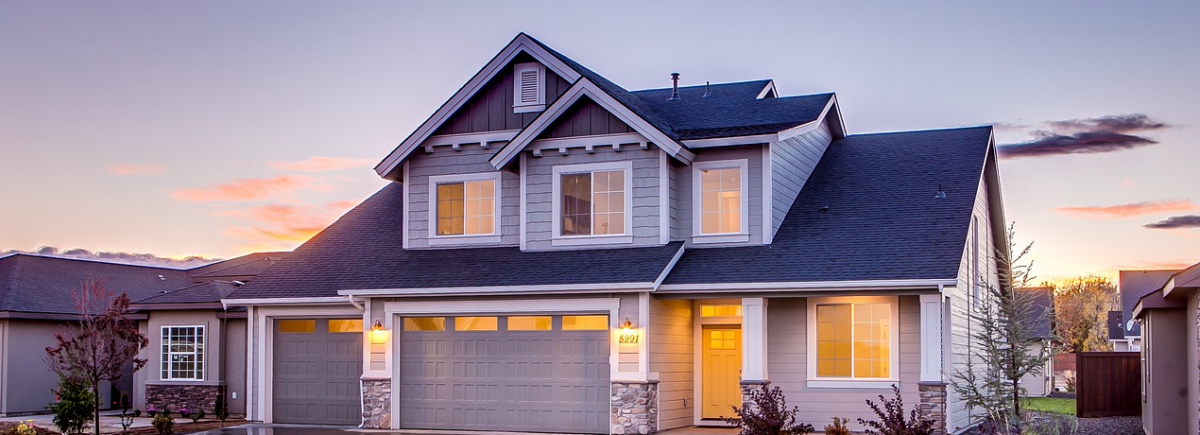
August 30, 2024
When calculating the cost of a loft conversion in the UK, several factors come into play that can significantly impact the final price. From the size of the space and the type of conversion—such as a Mansard or dormer extension—to additional features like en-suites or balconies, each element contributes to the overall building costs.
In this article, we’ll explore some of these variables and how they affect a project’s cost, to help you budget and plan your loft conversion.
10 Main Types of Loft Conversions
Before we take a look at the numbers, it’s important to be aware of the main options available when planning a loft conversion. Each type offers unique benefits and can significantly impact the overall cost and design of your project. Here are eight to be aware of:
- Velux Loft Conversion – The simplest and most cost-effective option, involving the installation of Velux windows into the existing roof space without altering the roof structure.
- Dormer Loft Conversion – Extending the roof outward to create additional space and headroom; they can be full-width or smaller, depending on the space requirements.
- Mansard Loft Conversion – Altering the roof structure to create a near-vertical wall with a flat roof, providing maximum space and headroom.
- Hip-to-Gable Loft Conversion – Replacing the sloping side of the roof with a vertical gable end, effectively increasing the roof space and headroom.
- Gable-to-Gable Loft Conversion – Similar to hip-to-gable, but it extends the existing gable end across the entire width of the property.
- Shell Loft Conversion – Provides the basic structure and space, leaving the interior finishes and fittings to the homeowner.
- Roof Lift Loft Conversion – Raising the entire roof structure to create additional headroom and floor space, often involving significant structural alterations.
- Modular Loft Conversion – A prefabricated solution where sections of the loft are constructed off-site and then assembled on your property.
- Piggyback Loft Conversion – Building an entirely new structure on top of the existing roof, effectively adding a new storey to the property
- Standard Loft Conversion – Predominantly internal work without major changes like roof lifts or complete rebuilds.
In this article, we’ll be reviewing three loft conversion types: a standard loft conversion, a dormer loft conversion, and a Mansard loft conversion. A dormer loft conversion often comprises a single window, two windows, or the full width of the roof.
Considerations For Converting A Loft
A fully finished attic is roughly 35–50% of the house’s ground floor square meterage, so we based our calculations on a floor space of 30m2.
In addition to the total costs, we’ve also provided costs per square metre, so you can carry out your own calculations if you happen to know the dimensions you’re working with.
All our calculations are based on a loft conversion comprising the following:
- Master bedroom
- En-suite bathroom
- Eaves storage
- Landing including stairs
In terms of build specification, our BuildPartner pricing tool gives you three options (which can be revised by item at a later point):
- Basic spec is a basic finish; e.g. Leyland, Everest, Wickes.
- Standard spec is a standard finish; e.g. Dulux, Hamilton, Slim Line.
- Premium spec is a high-spec finish; e.g. Farrow & Ball, Fine Line, Siemens.
In this cost comparison article, we review projects based on a standard spec. In addition to specification, we’ve provided a range of prices to reflect the varying types of contractors:
- Low benchmark – smaller companies are generally lower cost but less specialised and with low project management function; good for low/mid-spec projects and tight budgets.
- Mid benchmark – medium-sized companies offer a balanced mix of cost-effectiveness and specialisation; good for mid-range projects for effective execution within moderate budgets.
- High benchmark – larger companies generally have a higher cost base but can handle a wide variety of specialist tasks; good for mid/high-spec projects and project management.
Standard Loft Conversion
Here’s a table showing the average costs of a standard loft conversion for a standard-spec project in the UK:
| Standard Loft Conversion | Total Average Build Cost | Average Cost Per Sq Metre | ||||
| Low Benchmark | Mid Benchmark | High Benchmark | Low Benchmark | Mid Benchmark | High Benchmark | |
| East Anglia | £47,242 | £51,537 | £55,831 | £1,575 | £1,718 | £1,861 |
| London | £55,780 | £62,375 | £69,410 | £1,859 | £2,079 | £2,314 |
| Midlands | £45,774 | £49,935 | £54,096 | £1,526 | £1,664 | £1,803 |
| North England | £45,358 | £49,493 | £53,618 | £1,512 | £1,650 | £1,787 |
| Northern Ireland | £44,087 | £46,821 | £50,722 | £1,431 | £1,561 | £1,691 |
| Scotland | £45,256 | £49,370 | £53,484 | £1,509 | £1,646 | £1,783 |
| South East | £51,317 | £57,382 | £63,665 | £1,859 | £2,079 | £2,282 |
| South West | £46,528 | £52,825 | £57,979 | £1,575 | £1,761 | £1,933 |
| Wales | £45,815 | £51,229 | £55,279 | £1,527 | £1,708 | £1,843 |
| Average | £47,462 | £52,330 | £57,120 | £1,597 | £1,763 | £1,922 |
All costs exclude VAT.
Here’s what the data shows for the cost of standard loft conversion to a standard spec:
- It costs 23% more to convert a loft in London than in other regions.
- The minimum cost is £44,087, and the maximum cost is £69,410.
- The total average cost is £52,304, or £1,760 per square metre.
Cost Breakdown By Project Stage – London
Here’s an example of the associated costs for the different stages of a standard loft conversion for a standard-spec project – when using a mid-benchmark contractor in London:
| Total | £62,375 | 100% |
| Preliminaries | £10,900 | 17.5% |
| Demolitions | £1,679 | 2.7% |
| Floor structure and lining | £3,460 | 5.5% |
| Steel and structural supports | £5,735 | 9.2% |
| External wall structure and lining | £5,524 | 8.9% |
| Internal wall structure and lining | £3,855 | 6.2% |
| Ceiling structure and lining | £3,901 | 6.3% |
| External windows and doors | £3,070 | 4.9% |
| Internal doors and frames | £1,496 | 2.4% |
| Drainage and pipework | £782 | 1.3% |
| Heating and cooling | £1,643 | 2.6% |
| Wiring and fuseboards | £1,445 | 2.3% |
| Stairs, balustrades and lifts | £2,885 | 4.6% |
| Plumbed appliances | £2,742 | 4.4% |
| Wired appliances | £2,057 | 3.3% |
| Ceiling preparation and finishes | £426 | 0.7% |
| Wall preparation and finishes | £3,720 | 6.0% |
| Floor preparation and finishes | £3,452 | 5.5% |
| Decoration | £3,177 | 5.1% |
| Fixtures and fittings | £425 | 0.7% |
Cost Breakdown By Area – London
Here’s a breakdown of the associated costs by area for a standard-spec loft conversion – when using a mid-benchmark contractor in London:
| Total | £62,375 | 100% |
| Bedroom | £8,378 | 13.4% |
| Eaves storage | £1,492 | 2.4% |
| En-suite | £11,646 | 18.7% |
| Loft conversion | £36,720 | 58.9% |
| Landing incl. stairs | £4,139 | 6.6% |
Mansard Loft Conversion
Here’s a table showing the average building costs of carrying out a Mansard loft conversion for a standard-spec project in the UK:
| Mansard Loft Conversion | Total Average Build Cost | Average Cost Per Sq Metre | ||||
| Low Benchmark | Mid Benchmark | High Benchmark | Low Benchmark | Mid Benchmark | High Benchmark | |
| East Anglia | £61,480 | £67,069 | £72,658 | £2,049 | £2,236 | £2,422 |
| London | £71,417 | £79,861 | £88,602 | £2,381 | £2,662 | £2,953 |
| Midlands | £59,956 | £65,407 | £70,857 | £1,999 | £2,180 | £2,362 |
| North England | £59,511 | £64,933 | £70,343 | £1,984 | £2,164 | £2,345 |
| Northern Ireland | £58,129 | £62,081 | £67,254 | £1,897 | £2,069 | £2,242 |
| Scotland | £59,351 | £64,746 | £70,142 | £1,978 | £2,158 | £2,338 |
| South East | £65,704 | £73,469 | £80,637 | £2,381 | £2,662 | £2,922 |
| South West | £60,741 | £68,746 | £75,453 | £2,049 | £2,292 | £2,515 |
| Wales | £60,002 | £67,093 | £72,122 | £2,000 | £2,236 | £2,404 |
| Average | £61,810 | £68,156 | £74,230 | £2,080 | £2,296 | £2,500 |
All costs exclude VAT.
Here’s what the data shows for the cost of carrying out a Mansard loft conversion to a standard spec:
- The minimum cost is £58,129, and the maximum cost is £88,602.
- The total average cost is £68,065, or £2,292 per square metre.
Cost Breakdown By Project Stage – London
Here’s an example of the associated costs for the different stages of a Mansard loft conversion for a standard-spec project – when using a mid-benchmark contractor in London:
| Total | £79,861 | 100% |
| Preliminaries | £11,597 | 14.5% |
| Demolitions | £431 | 0.5% |
| Floor structure and lining | £3,652 | 4.6% |
| Steel and structural supports | £3,934 | 4.9% |
| External wall structure and lining | £15,478 | 19.4% |
| Internal wall structure and lining | £3,855 | 4.8% |
| Roof structure and coverings | £8,452 | 10.6% |
| Ceiling structure and lining | £1,221 | 1.5% |
| External windows and doors | £3,070 | 3.8% |
| Internal doors and frames | £1,496 | 1.9% |
| Drainage and pipework | £4,278 | 5.4% |
| Heating and cooling | £1,643 | 2.1% |
| Wiring and fuseboards | £1,868 | 2.3% |
| Stairs, balustrades and lifts | £2,885 | 3.6% |
| Plumbed appliances | £2,742 | 3.4% |
| Wired appliances | £2,057 | 2.6% |
| Ceiling preparation and finishes | £426 | 0.5% |
| Wall preparation and finishes | £3,720 | 4.7% |
| Floor preparation and finishes | £3,452 | 4.3% |
| Decoration | £3,177 | 4.0% |
| Fixtures and fittings | £425 | 0.5% |
Cost Breakdown By Area – London
Here’s a breakdown of the associated costs by area for a standard-spec Mansard loft conversion – when using a mid-benchmark contractor in London:
| Total | £79,861 | 100.0% |
| Bedroom | £8,378 | 10.5% |
| Eaves storage | £1,492 | 1.9% |
| En-suite | £11,646 | 14.6% |
| Mansard loft extension | £54,206 | 67.9% |
| Landing incl. stairs | £4,139 | 5.2% |
Dormer Loft Conversion
Here’s a table showing the average building costs of carrying out a dormer loft conversion for a standard-spec project in the UK:
| Dormer Loft Conversion | Total Average Build Cost | Average Cost Per Sq Metre | ||||
| Low Benchmark | Mid Benchmark | High Benchmark | Low Benchmark | Mid Benchmark | High Benchmark | |
| East Anglia | £55,222 | £60,242 | £65,263 | £1,841 | £2,008 | £2,175 |
| London | £63,353 | £70,844 | £78,705 | £2,112 | £2,361 | £2,623 |
| Midlands | £53,120 | £57,949 | £62,778 | £1,771 | £1,932 | £2,093 |
| North England | £52,694 | £57,485 | £62,275 | £1,756 | £1,916 | £2,076 |
| Northern Ireland | £51,640 | £56,335 | £61,029 | £1,721 | £1,878 | £2,034 |
| Scotland | £52,624 | £57,408 | £62,192 | £1,754 | £1,914 | £2,073 |
| South East | £58,285 | £65,173 | £72,309 | £1,943 | £2,172 | £2,410 |
| South West | £53,898 | £61,087 | £67,046 | £1,797 | £2,036 | £2,235 |
| Wales | £53,166 | £59,449 | £64,001 | £1,772 | £1,982 | £2,133 |
| Average | £54,889 | £60,663 | £66,178 | £1,830 | £2,022 | £2,206 |
All costs exclude VAT.
Here’s what the data shows for the cost of carrying out a dormer loft conversion to a standard spec:
- The minimum cost is £51,640, and the maximum cost is £78,705.
- The total average cost is £60,577, or £2,019 per square metre.
Cost Breakdown By Project Stage – London
Here’s an example of the associated costs for the different stages of a dormer loft conversion for a standard-spec project – when using a mid-benchmark contractor in London:
| Total | £70,844 | 100.0% |
| Preliminaries | £12,384 | 17.5% |
| Demolitions | £2,970 | 4.2% |
| Floor structure and lining | £3,263 | 4.6% |
| Steel and structural supports | £2,465 | 3.5% |
| External wall structure and lining | £10,455 | 14.8% |
| Internal wall structure and lining | £3,855 | 5.4% |
| Roof structure and coverings | £5,907 | 8.3% |
| Ceiling structure and lining | £1,221 | 1.7% |
| External windows and doors | £3,070 | 4.3% |
| Internal doors and frames | £1,496 | 2.1% |
| Drainage and pipework | £1,575 | 2.2% |
| Heating and cooling | £1,428 | 2.0% |
| Wiring and fuseboards | £1,868 | 2.6% |
| Stairs, balustrades and lifts | £2,885 | 4.1% |
| Plumbed appliances | £2,742 | 3.9% |
| Wired appliances | £2,057 | 2.9% |
| Ceiling preparation and finishes | £426 | 0.6% |
| Wall preparation and finishes | £3,720 | 5.3% |
| Floor preparation and finishes | £3,452 | 4.9% |
| Decoration | £3,177 | 4.5% |
| Fixtures and fittings | £425 | 0.6% |
Cost Breakdown By Area – London
Here’s a breakdown of the associated costs by area for a standard-spec dormer loft conversion – when using a mid-benchmark contractor in London:
| Total | £70,844 | 100.0% |
| Bedroom | £8,378 | 11.8% |
| Eaves storage | £1,492 | 2.1% |
| En-suite | £11,646 | 16.4% |
| Dormer loft extension | £45,189 | 63.8% |
| Landing incl. stairs | £4,139 | 5.8% |
Summary Of Loft Conversion Costs
So, how much does a loft conversion cost in the UK? Based on the three different conversions covered in this article (standard, dormer, and Mansard), you can expect a loft conversion to cost on average (when using a mid-benchmark contractor):
- Standard loft conversion – £52,304, or £1,760 per sq metre.
- Mansard loft conversion – £68,065, or £2,292 per sq metre.
- Dormer loft conversion – £60,577, or £2,019 per sq metre.
Please remember that these costs do not include VAT, and there may be other additional costs, such as obtaining planning permission, conducting structural surveys, making unexpected repairs, and completing custom finishes.
Frequently Asked Questions About Loft Conversions
Here are some FAQs about loft conversions.
Do I need to move out during the loft conversion?
You rarely need to move out during most loft conversions. However, there will be noise, dust, and workers coming in and out, which can be particularly inconvenient if you work from home. For a roof lift loft conversion, which involves raising the existing roof to create additional headroom, many contractors recommend staying elsewhere until the property is weatherproofed.
How much headroom is required for a loft conversion?
Building Regulations require a minimum headroom of 2.2 metres (7 feet 2 inches) for a loft conversion, taken from the floor to the highest point of the ceiling. If your loft has less headroom, you may still be able to proceed by adjusting the roofline or lowering the ceiling of the floor below.
Can I convert a loft into a terraced or semi-detached house?
Yes, but you’ll need to consider specific factors, such as shared walls with neighbours (party walls), which may require a party wall agreement. Additionally, planning permission might be needed if your conversion alters the roofline or if your property is in a conservation area.
What fire safety regulations apply for loft conversions?
In the UK, loft conversions must comply with strict fire regulations. This includes installing fire-resistant (30-minute rated) doors on all access points to the loft, creating a protected escape route with enclosed, fire-resistant walls and doors, and fitting mains-powered, interlinked smoke alarms on each floor. Emergency escape windows or alternative exits are also required.
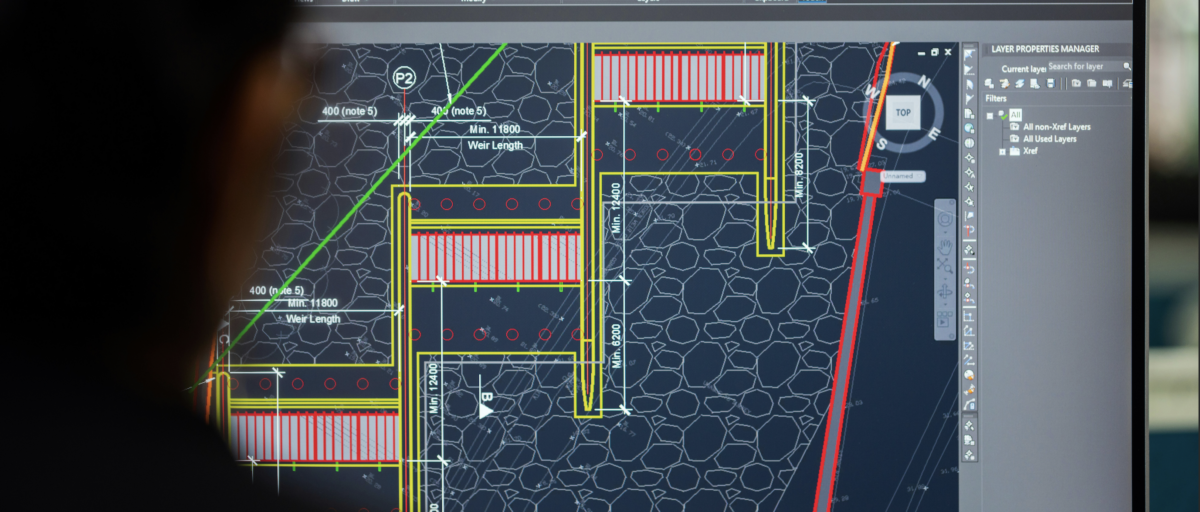
August 22, 2024
Investing in the right construction estimation software can revolutionise your workflow, saving you valuable time and money. The days of painstakingly calculating project costs with spreadsheets are quickly becoming a thing of the past, and you don’t need to be a technical maestro to get to grips with newer alternatives.
We’ve compiled a list of the five best construction estimation software options for UK contractors. These tools are designed to enhance accuracy, improve workflow, and help you win more bids.
Read on to discover the top estimation software that can transform how you manage your construction projects.
4 Types of Construction Estimation Options
Before we get into the nuts and bolts of the best construction estimation software, let’s take a quick look at the four different types out there.
- Estimating Software – Specifically suited for pricing, these tools help contractors save prices and generate detailed cost estimates. Examples include BuildPartner, Price Builder, and Buildxact.
- Project Management Software – While primarily focused on wider project management, such as lead management and site management, these tools often have some basic quote creation functionality. Examples include Houzz and Procore.
- Estimating Services – Professional estimation assistance by experts who provide cost estimates as a service. Examples include Build Aviator, Estimators Online, and My Build Estimate.
- Takeoff Software – Software specialising in listing all the quantities needed for a construction project (but doesn’t feature prices). Examples include Bluebeam and PlanSwift.
In this article, we’ll exclusively cover estimation software, which allows you to generate estimates and quotes for the various stages of a project.
1. BuildPartner
BuildPartner is an intuitive estimation platform that allows you to generate accurate benchmark costs for a project in minutes. It does this by enabling users to share information with each other and creating a live database of thousands of projects, tasks, and materials.
Simply enter the region, select the specification, project type, and construction project rooms and shells, and the pricing tool will populate the estimate and show you average prices in your area. You can then refine specifications, labour and materials rates and margins to suit you.
You’ll have a localised, accurate quote for your build in just a few clicks.

Pros
The wide range of template tasks and projects makes it easy for users of any experience to create accurate quotes and cost plans within minutes.
This speed of cost plan creation is unique and provides a reliable indicator of project cost early in the design process, which is of huge benefit to both contractors and clients.
To create or receive a quote for a project, you simply click your way through a series of five screens—choosing the build type and which rooms are included.
The speed at which you can produce an accurate quotation is unmatched, so contractors can be more agile in responding to requests and tenders.
Being able to produce itemised quotations so quickly is hugely attractive to clients, and many BuildPartner users see a marked improvement in their bid-hit ratio. So, users stand to win more work by producing detailed, accurate quotes.
In the event that a client awards the contract to another firm, you haven’t wasted several hours calculating a quote and researching prices.
BuildPartner is user-friendly and incredibly easy to navigate. It doesn’t have the complex analytical matrix-style dashboard that accompanies other pricing tools. You’ve got everything you need, from project timelines to itemised cost schedules, cost breakdowns, and Excel exports.
Once you’ve created your initial quote, you can refine it by adding and removing any items as required and by overriding room dimensions.
It's one of the few platforms that’s accessible to everyone, from technical pricing teams in corporations to sole traders who are less savvy with IT.
BuildPartner is cloud-based, so it requires no download and can be accessed anywhere on any device.
Cons
Anything is possible with this product; you can edit projects and tasks in minute detail. However, because it is structured, the tradeoff for speed and simplicity is that it’s harder to customise, for example, to create unique tasks and structures for unusual projects.
However, in instances where a particular building material or task is absent, the BuildPartner team is known for supporting users and advising on a reasonable provisional sum to include. The level of service and speed of answering questions is excellent.
Some larger companies may find the limitations on the number of projects restrictive. With BuildPartner, you can quote for the following number of projects for each tier per month: Basic (5), Standard (10), and Pro (15). But they have enterprise options for people going over that number.
Verdict
BuildPartner is an excellent way of quickly providing your clients with quick and accurate estimates. The detailed breakdown ensures your clients have total transparency and confidence in the quoted figures.
An additional benefit is that the subscription doesn't charge per user. Each service plan allows you to invite an additional user, so you won’t be charged exorbitant fees if you’re using within a small practise.
There’s no obligation to pay annually, and you can cancel anytime. It’s also one of the better value options compared to those in this review, by a considerable margin, being over three times cheaper than Buildxact.
Summary
- Free Trial: Yes
- Cost:
- Starter: £24 + VAT/month
- Standard: £46 + VAT/month
- Pro: £68 + VAT/month
- Capterra Rating: 4.6 out of 5, from 90 reviews
- Link: https://buildpartner.com/
2. Price Builder
Price Builder is a tool that enables the fast and precise generation of professional quotations for clients. It simplifies the pricing process, saving time and reducing errors. Prices are calculated using accurate preprogrammed algorithms.
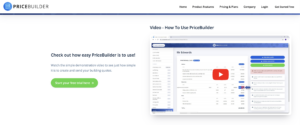
Pros
Price Builder is more suited to those who prefer a hands-on approach to quote generation. Whereas BuildPartner does all the heavy lifting and calculation for you, Price Builder requires you to manually enter the details of projects.
Among the estimation tools reviewed, Price Builder offers the most intuitive user experience. The interface is highly responsive to the user’s actions, with on-page elements popping out, enlarging, or changing colour when hovering over.
If Price Builder was an operating system, it would be more akin to iOS than Android. It doesn’t have that clunky or outdated feel like esti-mate or HBXL.
Aside from being a fluid system, the real benefit of this is the ease and efficiency of quote creation, and you can do all this on the go from your mobile, tablet, or laptop.
The pricing is simple and cost-effective. As with BuildPartner, you can cancel anytime and aren’t trapped in an annual subscription, like HBXL—which features later in this review and costs over £649 per year for its cheapest subscription.
Cons
The biggest drawback of Price Builder is the need to laboriously enter several fields of data manually. This is in contrast to BuildPartner, in which a benchmark quote can be generated in a matter of minutes, in literally just a few clicks.
For instance, when using Price Builder, you start with a blank list of around 20 categories, including Preliminary Costs, Scaffolding, Demolition, Foundations, Walls, and Pitched Roof.
Users then need to enter specifics in each category, such as the quantities and lengths of materials required. You could spend a considerable amount of time quoting for a project for which you may not be awarded, which somewhat defeats the object.
For instance, in the Preliminary Costs category, you’ll be prompted to manually enter information such as Site Supervision (Days), General Builder (Days), Labourer (Days), Drive/Garden/Patio Protection (m2), General Rubbish Skips, and more.
Theoretically, much of this could be done in a spreadsheet since the process is reliant on data entry.
You’ll need to work through every section in order to generate a quote.
Verdict
There’s a considerable lack of reviews out there for Price Builder. As of July 2024, there are no reviews yet on Trustpilot or Capterra, so it’s a company with little to no online reputation.
It’s a fairly time-consuming platform and less suited to those looking to generate quotes at speed. But it’s a decent tool for those who need some organisation and structure when it comes to streamlining their quoting process.
Summary
- Free Trial: Yes
- Cost:
- Basic: £25/month
- Professional: £35/month
- Pro: £45/month
- Capterra Rating: 0 out of 5, from 0 reviews
- Link: https://www.pricebuilder.co.uk/
3. Buildxact
Buildxact is a comprehensive construction management software for estimating, job management, and project tracking. Given that it’s a comprehensive offering that comes with a tonne of other features like lead management, cost tracking, and invoicing, it’s more expensive than the likes of BuildPartner and Price Builder.
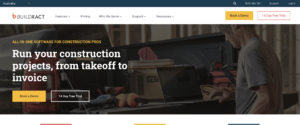
Pros
Buildxact pitches itself as a sophisticated software solution and goes beyond mere estimation. It has a host of other features, such as lead management, customer communication, takeoffs, scheduling, cost tracking, site management, and invoicing.
It’s a one-stop shop for managing construction projects, but it’s not for everyone.
The learning curve is steeper than other software in this review, but once you’ve created your own template for a project, each successive estimation becomes invariably easier.
This is particularly useful if you offer bespoke services and use similar materials and contractors from one project to the next.
To get started, you can create your estimate using one of the five default templates: Duplex (Single Storey), Extension, Kitchen and Bathroom, Landscaping, Single-Storey House.
However, this is a fairly limited offering compared to the plethora of selections available when using BuildPartner, which covers all manner of build types (refurb, remodel, extension, builds) and a variety of rooms and shells.
After generating a quote with Buildxact, you’ll be presented with a professionally formatted document, which features a slick Gantt chart schedule that is likely to be appreciated by project managers, who always want to know what is happening and when.
The other huge time-saver is the ability to integrate the software with supplier catalogues and accounting software such as Xero, Quickbooks, and Deputy. It’s the only software in this review that allows for integrations of any kind.
Cons
Estimating a project’s cost with Buildxact is a slow process, even when a decent template is used. It requires a lot of line-by-line reviewing and checking to ensure everything is captured.
There are over 40 categories for which to enter data, and you need to upload plans, which may not always be immediately available when a client requires an indicative quote.
This exhaustive list comprising over 40 categories, when viewed together, requires an excessive amount of scrolling. Navigation with Buildxact represents a challenge, even when zooming out in the desktop version.
Those looking exclusively for estimation service rather than a CRM system would be better off starting out with a more convenient solution like BuildPartner—one which has a steady learning curve.
When using Buildxact, the chatbot pop-up notifications are particularly invasive and get in the way. It’s only a small peeve, but it’s a distraction nonetheless.
Despite being a cloud-based software solution, Buildxact only recently released an onsite mobile app. It has limited functionality and can only be used to manage and view updates rather than generate quotes. What good is the app if it cannot perform its primary function?
Also, the free trial only lasts 14 days, which doesn’t feel long enough to fully explore the system.
Verdict
Those looking for a complete CRM solution that includes estimation software may find Buildxact to be a cost-effective solution, but it comes with a steep learning curve.
Users should be aware that plans must be uploaded and data entered manually to generate an accurate quote. It’s not a mobile-friendly software solution, which makes it difficult to access and amend quotations when on the go.
Summary
- Free Trial: Yes
- Cost:
- Entry: £88/month (billed annually)
- Pro: £160/month (billed annually)
- Capterra Rating: 4.6 out of 5, from 156 reviews
- Link: https://www.buildxact.com/uk/
4. HBXL - EstimatorXpress
Whether your converting a loft or undertaking a new build, HBXL’s EstimatorXpress can be used for projects both large and small. HBXL also offers other complementary project software, such as PlansXpress, BuildProjex, Health & Safety Xpert, ProjectXpert, and ContractsXpert.
Pros
HBXL offers hundreds of estimating templates to get you started, from renovation work to extensions, loft conversions to new builds.
Each template is made up of the relevant estimating calculators (over 600 in total) to get you quoting quickly. Take, for instance, the ‘attic block wall’ calculator. It’s loaded with priced blocks, steel to build the wall on, plaster, skirting, materials for decoration, and the associated labour.
Simply scroll down the categories and answer a few questions in each. Most of these questions appear in the form of dropdown lists or check boxes, which makes the process much simpler than having to manually key in information like when using Price Builder.
Once you’ve worked through the categories (Floors, Roofs, etc.), simply enter your dimensions and tweak the spec to generate your quote.
Material prices are live, too. The built-in price book, Price Tracker+, keeps your price book up to date by scouring the internet for the latest prices.
And if you have your own special prices or labour rates, you can change them as you see fit. Your quote is fully customisable. The fields are pre-populated for each trade. You can leave it as is or adjust it to reflect your local conditions.
HBXL reports are about the most advanced available in the software options presented in this review. These readymade reports show you cash flow projections, a breakdown of your plant costs, your spend on labour hours, and your sub-contractor outlay, and they allow you to keep track of all your expenditures.
Cons
It’s unusual in this day and age for premium software to come in a downloadable format rather than being cloud-based. When using cloud-based software like BuildPartner, you can access it from any device, anytime—for convenience.
Not only that, but cloud-based platforms receive automatic updates, ensuring users always have the latest features and security patches without having to manually update.
Be aware that EstimatorXpress takes up nearly 1GB of your storage
It’s also a huge inconvenience if you just want to undertake a trial. You’ve got to download it, jump through a load of hoops to set it up, and then have a call with a sales rep at HBXL.
From a functionality perspective, you need a Windows computer with Microsoft Excel installed. So, if you’re using Linux or IOS, you won’t be able to try this.
It can be buggy, too, and HBXL’s response to this is:
“Microsoft Office has become increasingly unstable within the last 18 months with numerous updates fundamentally altering the way Excel works and causing issues for all companies who provide Excel-based software programmes.”
While transparent, it’s perhaps not the most reassuring.
And since HBXL is Excel-based, don’t expect a modern and intuitive experience.
Verdict
HBXL is a great solution for those who cannot part with Excel spreadsheets, especially those who like to get into the granular detail of number crunching and analysing reports.
While expensive, there is an option for outright purchase, too, so if you try it and instinctively know this is the right software for you, then you may well benefit from committing to a one-time fee.
Summary
- Free Trial: Yes
- Cost:
- EstimatorXpress Plus: £649/year
- EstimatorXpress Premium: £799/year
- EstimatorXpress Plus: £1,599 (outright purchase)
- EstimatorXpress Premium: £1,999 (outright purchase)
- Trustpilot Rating: 4.5 out of 5, from 81 reviews
- Link: https://hbxl.co.uk/
5. esti-mate
esti-mate provides a powerful piece of estimating software that can be used for all sizes and types of jobs, including small and large building projects and civil engineering work, as well as specialist trades. It’s a Windows-based program rather than cloud-based software.
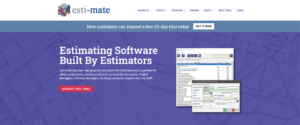
Pros
esti-mate software allows users to produce quotations, schedules, and traditional bill of quantities quickly and in a variety of ways, which can then be emailed or printed as a set of professional documents.
One handy feature is that groups of items can be rapidly located and displayed as a single list. Such grouping includes items that have not yet been priced, items containing selected resources, and items over a selected value.
It’s also incredibly easy to add, copy, or amend items.
Perhaps the most distinctive feature of esti-mate is the ability to add in waste factors for individual items or globally across all items, giving you greater control and visibility of costs to prevent overrun. This is the only software in this review that isolates and attributes a value to waste.
esti-mate also offers a true multi-user experience, meaning the program can be set to run in multi-user mode, allowing more than one user to view the same job at the same time—at no extra cost with no limits on the number of users.
While it would make an expensive platform for a small business, medium to larger companies would benefit from unlimited user access on a single licence.
Cons
Getting started with esti-mate is slow and cumbersome. If you’re looking to take them up on the offer of a 20-day free trial, don’t be fooled into thinking you can access the download right away despite the prompts on their website.
You’ll need to fill out a form and then hit “Download”. But even after that, you’ll be greeted with a pop-up message that says a member of the esti-mate team will be in touch.
esti-mate is also one of the most expensive options straight out of the box. The downloadable software costs £1,270 for a one-time purchase, but users are also encouraged to attend a two-day training course onsite (£1,900). It’s completely unaffordable for smaller firms, despite claims of the opposite on their website.
The software itself looks like a programme straight out of the '90s. This begs the question: if the front end looks dated, is the backend also being neglected?
You would hope that resources and capital are being poured in to fuel innovation, much like BuildPartner, which is developing automated plan-reading capabilities that would automatically produce a benchmark quotation based on a project’s plans.
With esti-mate, there is no mention on the website with regards to how often the pricing library is updated, so it’s reasonable to assume that prices are not live like BuildPartner’s or HBXL’s.
The software only runs on Windows, so again, Linux and iOS users have no choice but to look elsewhere, and it also means that those using Windows wouldn’t be able to switch to iOS at a later date (at least, not without having to find another estimating software programme to replace esti-mate.)
Verdict
esti-mate is overpriced for a seemingly dated programme. The software itself is expensive, and the steep learning curve requires one to two days of onsite training, costing up to £2,000. Any software that requires a period of consolidated training and study is likely to be unsuitable for small businesses.
Everything from the software programme to the website and its content seems frozen in time. Despite this, many industry professionals use it daily. The strongest draw is that it offers better value for money when used by multiple users, as there is no additional cost per user.
Still, esti-mate’s reputation is hard to validate, with only three unverified testimonials on its website and no reviews on Capterra or Trustpilot.
Summary
- Free Trial: Yes
- Cost:
- esti-mate software: £1,270 - Capterra Rating: 0 out of 5, from 0 reviews
- Link: https://estimate.co.uk/
Best Pricing Tools for Construction Companies
When choosing the best estimation software, your main concern is the accuracy of cost estimation. Inaccurate software leads to cost overruns, so estimation software that uses a real-time database of prices and accurate estimations will help you win more bids and run more profitably. Take advantage of the free trials available at your disposal, starting with BuildPartner, of course.
Frequently Asked Questions About Construction Estimation Software
Below are some frequently asked questions about construction estimation software.
Is construction estimation software suitable for small businesses?
Yes, there are scalable solutions available that cater to small businesses, offering essential features without overwhelming complexity. The right software will simplify the process for small to medium businesses through automated calculations and itemised schedules, reducing the time spent on manual data entry and revisions.
What is Procore?
Procore is a comprehensive construction management software that offers tools for scheduling, document management, cost tracking, quality and safety monitoring, and mobile access. It’s generally suited to bigger construction companies quoting for projects over £1m.
Is Easy Price Pro still trading?
Build Aviator acquired the estimating software Easy Price Pro back in 2017. However, the software arm of Build Aviator closed in February 2024, and they now focus exclusively on providing estimating services. That means users of the software can no longer access the previous platforms, and any information published on the web regarding those (i.e., reviews and discussions) is now redundant.
What should I look for in construction estimation software?
Your main concern is the accuracy of cost estimation. Inaccurate software will lead to cost overruns. Estimation software that uses a real-time database of prices and accurate estimation templates will help you avoid overspending and ensure no key materials are missed due to human error.
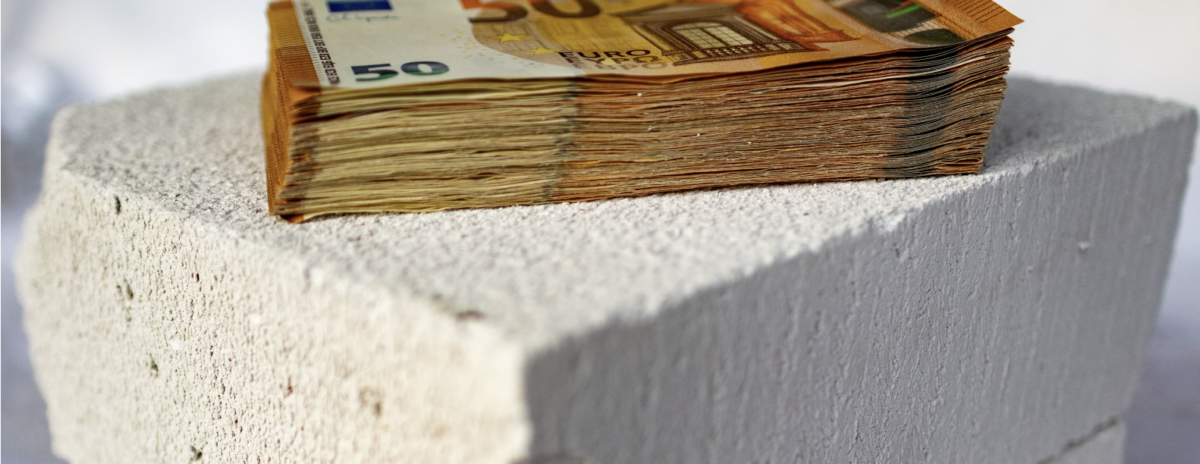
June 30, 2024
The Department for Business has recently published the latest statistics on construction prices in the UK. In this article, we’ll explore the commentary and statistics, such as construction material price indices, bricks and blocks production, and imports and exports.
We’ll look at this and more, without the jargon, to help you understand the direction the construction industry is heading in and to help you interpret what that could mean for you.
Material Price Indices – Inflation
The material price indices tracks the changes in prices of various construction materials over time, providing a strong indicator of inflation (or deflation) within the construction industry. It comprises pricing data across numerous categories:
- Aggregates – e.g., gravel, sand, and bitumen.
- Cement and concrete – e.g., precast concrete, ready-mixed concrete, and fibre cement.
- Clay products – e.g., bricks, ceramic sanitaryware, and tiles.
- Metal products – e.g., central heating boilers, fabricated steel, and screws.
- Plastic products – e.g., pipes, windows, and floor coverings.
- Timber – e.g., plywood, planed wood, and particle board.
- Other building materials – e.g., plasterboard, paint, and insulation.
Here’s how building material prices have been affected by inflation over the last decade:
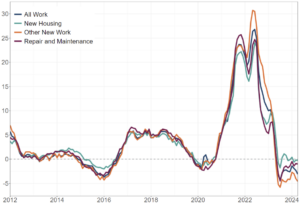
No surprises that the last few years have seen volatile inflation. The peak in 2021/22 occurred during the Covid-19 pandemic when there was a sharp rise in demand and supply shortages.
Important! The above graph depicts inflation year on year, not actual price changes. For instance, post-pandemic, the inflation rate slowed, but prices actually continued to rise.
Prices for “All Work” are now in a state of deflation, and have decreased a further 3.1% in April 2024 compared to April 2023, but now seem to have plateaued. Prices for “New Housing” decreased a negligible 0.2% year on year.
Biggest Movers In 12 Months (April 23 – April 24)
As far as actual construction material prices are concerned, here are the biggest movers in a 12-month period from April 23 to April 24:
| Construction materials | % change |
| Pipes and fittings | 19.3 |
| Metal doors and windows | 17.7 |
| Gravel, sand, clays, and kaolin – excl. aggregate levy | 11.3 |
| Gravel, sand, clays, and kaolin – incl. aggregate levy | -12.8 |
| Concrete reinforcing bars (steel) | -18.0 |
| Fabricated structural steel | -22.7 |
Production of Bricks, Blocks, and Concrete
The production of bricks, blocks, and concrete is perhaps the most significant indicator of the demand for construction projects; these figures provide a tangible measure of construction activity in the industry.
| Seasonally adjusted deliveries of bricks | Seasonally adjusted deliveries of concrete blocks |
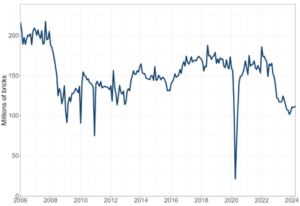 |
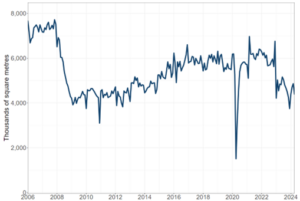 |
| Seasonally adjusted sales of ready-mixed concrete | Seasonally adjusted sales of sand and gravel |
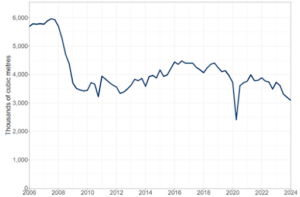 |
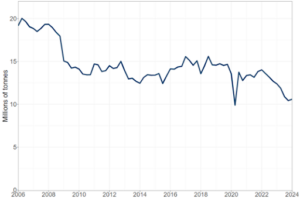 |
In all four charts, the trend is broadly the same. Sales (in volume) and deliveries of these building components have reached their lowest point in almost two decades, with the exception of the sharp decline at the outset of the pandemic (in 2020) due to lockdown measures. The last two years are responsible for a further 20–30% decline in output.
What does a decrease in demand mean for prices? If we drill down into the data, we can see that prices for these commodities are actually moving upward:
| Index | 2019 | 2020 | 2021 | 2022 | 2023 |
| Gravel, sand, clays and kaolin | 116.1 | 119.3 | 126.4 | 152.4 | 157.4 |
| Precast concrete: blocks, bricks, tiles and flagstones | 114.3 | 115.8 | 119 | 145.2 | 161.4 |
| Ready-mixed concrete | 103.5 | 101.2 | 107.2 | 126.5 | 147.2 |
| All bricks | [c] | [c] | [c] | [c] | [c] |
[c] represents confidential data.
These commodities are less affected by a reduction in demand because they are necessities, that is, without them, most construction jobs cannot be completed.
Imports and Exports
Where are building merchants and suppliers sourcing their products? There is an increasing trend towards importing building materials and components, especially since Brexit, while UK exports to other countries have been stagnant over the last decade.
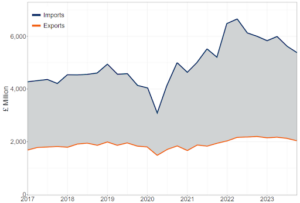
- Most of the exports are to Ireland (£1.55bn), USA (£1.01bn), Germany (£0.75bn), the Netherlands (£0.65bn), and France (£0.55bn).
- Most of the imports are from China (£4.53bn), Germany (£2.13bn), Italy (£1.31bn), Spain (£1.25bn), and Turkey (£1.06bn).
|
Top 5 exports |
£(million) |
Top 5 imports |
£(million) |
| Electrical wires | 1,023 | Electrical wires | 2,756 |
| Paints and varnishes | 862 | Lamps and fittings | 1,090 |
| Lamps and fittings | 422 | Sawn wood (> 6mm) | 1,024 |
| Air-con equipment | 419 | Air-con equipment | 994 |
| Linoleum flooring | 360 | Ironmongery | 915 |
The annual trade deficit is widening because foreign suppliers can provide commodities much cheaper than UK suppliers. Almost as many building materials are now sourced from China as from Germany, Italy, and Spain combined.
What About Construction Output?
The Bank of England published its most recent update to the Agents’ Summary of Business Conditions in March. While no specific figures were reported, the report suggests that:
- Construction output volumes continue to fall
- House building has fallen markedly over the last year
- Commercial development continues to slow
- Housing associations continue to reduce new builds.
Some figures published by the Office for National Statistics (ONS) support this, suggesting that quarterly construction output saw a decrease of 0.9% in Quarter 1 (Jan to Mar) 2024 compared with Quarter 4 (Oct to Dec) 2023.
As for the overall housing market, the sentiment is slightly more positive among estate agents and economists:
- House prices appear to have bottomed out and are now expected to stay flat or grow modestly over the next few months.
- There are early signs of an improvement in demand, due to more supportive mortgage rates.
In terms of commercial real estate, development is broadly flat year on year and remains very weak, by historical standards. Developers cite the interest rate environment as the reason for this.
What About Construction Wages?
According to Statista, in March 2024, the average weekly wage of construction workers in the UK reached £739, which has been fairly flat for the last four years.
The chart below shows the average weekly earnings in the construction sector in the UK from June 2000 to March 2024.
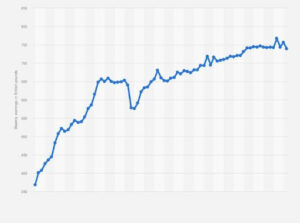
This rise in wages is symptomatic of the shortage of labour in the construction industry, with vacancies reaching a peak of over 45,000 towards the end of 2023, the highest amount ever recorded.
Summary Of UK Construction Costs
Construction material prices are deflating, but this is likely a temporary adjustment following successive months, if not years, of price increases. In theory, prices dropping means it’s slightly easier for construction firms to lower their costs and pass on the savings to homeowners and developers.
However, the reality is that the current rate of deflation is unlikely to stimulate any real demand in the short term. Only a period of sustained deflation would present an opportunity for a significant shift in consumer behaviour and an increase in output.
Frequently Asked Questions About UK Construction Costs
Here are some frequently asked questions about the building costs in the UK.
How much does it cost to build a 3-bed house in the UK?
Based on the houses we covered in this article, you can expect a 3-bedroom house with a gross internal floor area of 110 square metres to cost around £279,597, or £2,541 per square metre (including labour and building materials). These costs vary by region.
How much does it cost to build an extension in the UK?
Based on the types of extension we covered in this article, you can expect a single-storey rear extension (gross external area of 30 square metres) to cost around £78,186 and a double-storey rear extension (with a gross external area of 60 square metres) to cost around £136,525. These costs vary by region.
How much does it cost to build a bungalow in the UK?
Based on the bungalows we covered in this article, you can expect building a two-bed bungalow (90m2) to cost £174,257, a three-bed bungalow (100m2) to cost £188,284, and a three-bed bungalow with garage and driveway (125m2) to cost £198,801. These costs vary by region.
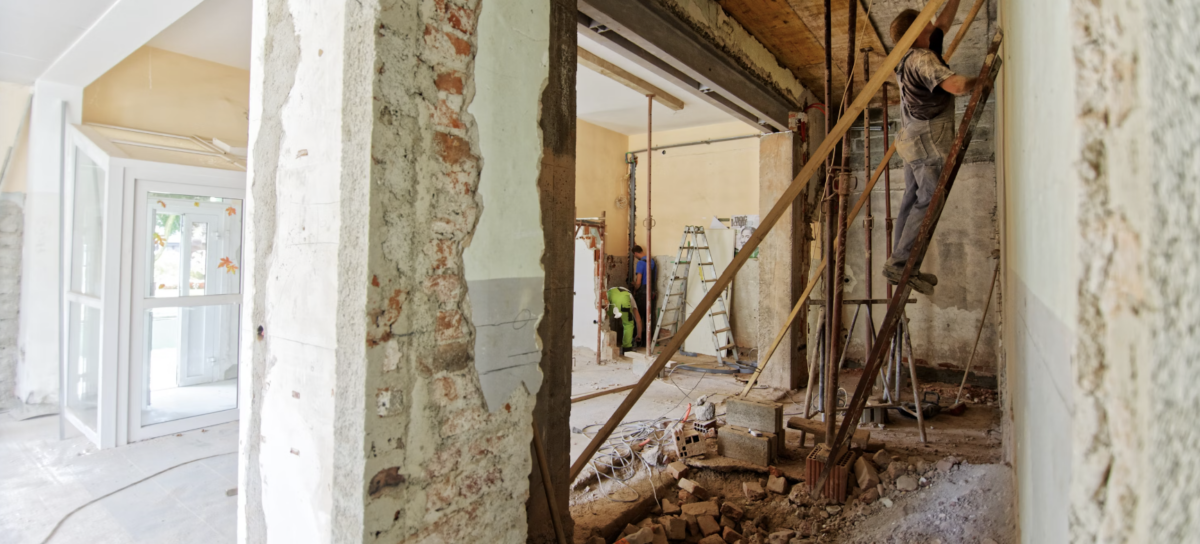
June 30, 2024
When calculating the costs for a home renovation, it’s easy to drown in a sea of variables such as what materials to include and exclude, what specifications to choose, and regional price variations. So, we’ve done the analysis for you.
In this 2024 guide, we provide several comprehensive cost breakdowns. We compare three different types of specifications (basic, standard, and high), to accommodate a range of budgets, and we also break the cost down per square metre.
Renovating A 3-Bedroom House
Before we look at the numbers, here are some things we’ve factored into the cost of renovating a 3-bedroom house:
- The total floor area of the average house in the UK is 94m2. All our calculations are based on a house of this size comprising three bedrooms, one bathroom, one kitchen, one WC, one living room, a landing, and an entrance hall.
- All appliances are included in the price, such as a built-in dishwasher, fridge, freezer, washing machine, extractor fan, hob, and oven. The only exclusion is a central heating boiler (radiators are included).
- A renovation (or house refurbishment) is not to be confused with a remodel. A renovation focuses exclusively on replacing the finishings and fittings in their existing locations and does not involve changing the layout of a structure.
In terms of build specification, our BuildPartner pricing tool gives you three options (which can be revised by item at a later point):
- Basic spec is a basic finish; e.g. Leyland, Everest, Wickes.
- Standard spec is a standard finish; e.g. Dulux, Hamilton, Slim Line.
- Premium spec is a high-spec finish; e.g. Farrow & Ball, Fine Line, Siemens.
For each specification, we’ve provided a range of prices to reflect the varying types of contractors:
- Low benchmark – smaller companies are generally lower cost but less specialised and with low project management function; good for low/mid-spec projects and tight budgets.
- Mid benchmark – medium-sized companies offer a balanced mix of cost-effectiveness and specialisation; good for mid-range projects for effective execution within moderate budgets.
- High benchmark – larger companies generally have a higher cost base but can handle a wide variety of specialist tasks; good for mid/high-spec projects and project management.
Cost Of A Basic-Spec Renovation
Here’s a table showing the average building costs of renovating a 3-bed house for a basic-spec project in the UK:
| 3-Bedroom House Refurb (Basic Spec) | Total Average Build Cost | Average Cost Per Sq Metre | ||||
| Low-Benchmark Contractor | Mid-Benchmark Contractor |
High Benchmark Contractor |
Low-Benchmark Contractor |
Mid-Benchmark Contractor |
High-Benchmark Contractor |
|
| East Anglia | £ 41,301 | £ 45,056 | £ 48,810 | £439 | £479 | £519 |
| London | £ 50,110 | £ 56,586 | £ 62,138 | £533 | £602 | £661 |
| Midlands | £ 39,937 | £ 43,568 | £ 47,198 | £425 | £463 | £502 |
| North England | £ 39,502 | £ 43,093 | £ 46,684 | £420 | £458 | £497 |
| N. Ireland | £ 38,357 | £ 40,686 | £ 44,076 | £397 | £433 | £469 |
| Scotland | £ 39,418 | £ 43,001 | £ 46,585 | £419 | £457 | £496 |
| South East | £ 46,102 | £ 51,550 | £ 57,194 | £533 | £596 | £654 |
| South West | £ 40,666 | £ 46,182 | £ 50,688 | £439 | £491 | £539 |
| Wales | £ 40,030 | £ 44,761 | £ 48,335 | £426 | £476 | £514 |
| Average | £ 41,714 | £ 46,054 | £ 50,190 | £448 | £495 | £539 |
All costs exclude VAT.
Here’s what the data shows for the cost of renovating a 3-bed house to a basic spec:
- It costs 26% more to renovate a 3-bed house in London than in other regions.
- The minimum cost is £38,357 and the maximum cost is £62,138.
- The total average cost is £45,986, or £494 per square metre.
Renovation Cost Breakdown By Project Stage – London
Here’s an example of the associated costs for the different stages of a renovation for a basic-spec project – when using a mid-benchmark contractor in London:
| Total | £56,586 | 100.0% |
| Preliminaries | £51 | 0.1% |
| Demolitions | £4,043 | 7.1% |
| Heating and cooling | £2,772 | 4.9% |
| Plumbed appliances | £3,347 | 5.9% |
| Wired appliances | £7,513 | 13.3% |
| Wall preparation and finishes | £2,477 | 4.4% |
| Floor preparation and finishes | £9,948 | 17.6% |
| Units, worktops and kitchen appliances | £10,828 | 19.1% |
| Decoration | £15,092 | 26.7% |
| Fixtures and fittings | £515 | 0.9% |
Renovation Cost Breakdown By Room – London
Here’s a breakdown of the associated costs by room for a basic-spec renovation project – when using a mid-benchmark contractor in London:
| Total | £56,586 | 100% |
| Bathroom | £8,644 | 15.3% |
| Bedroom 1 | £5,744 | 10.2% |
| Bedroom 2 | £5,744 | 10.2% |
| Bedroom 3 | £5,744 | 10.2% |
| Entrance Hall | £2,807 | 5.0% |
| Kitchen | £20,933 | 37.0% |
| Landing/stairs | £2,539.03 | 4.5% |
| WC | £4,432.45 | 7.8% |
Remember, appliances are included in the costs, which is why the kitchen accounts for a disproportionate amount of the total expense.
Cost Of A Standard-Spec Renovation
Here’s a table showing the average building costs of renovating a 3-bed house for a standard-spec project in the UK:
| 3-Bedroom House Refurb (Standard Spec) | Total Average Build Cost | Average Cost Per Sq Metre | ||||
| Low-Benchmark Contractor |
Mid-Benchmark Contractor | High-Benchmark Contractor | Low-Benchmark Contractor | Mid-Benchmark Contractor | High-Benchmark Contractor | |
| East Anglia | £52,842 | £57,646 | £62,450 | £562 | £613 | £664 |
| London | £61,652 | £69,492 | £76,302 | £656 | £739 | £812 |
| Midlands | £51,478 | £56,158 | £60,837 | £548 | £597 | £647 |
| North England | £51,043 | £55,684 | £60,324 | £543 | £592 | £642 |
| N. Ireland | £49,898 | £53,276 | £57,716 | £520 | £567 | £614 |
| Scotland | £50,959 | £55,591 | £60,224 | £542 | £591 | £641 |
| South East | £56,719 | £63,423 | £69,610 | £656 | £733 | £805 |
| South West | £52,207 | £59,087 | £64,852 | £562 | £629 | £690 |
| Wales | £51,571 | £57,666 | £61,974 | £549 | £613 | £659 |
| Average | £53,152 | £58,669 | £63,810 | £571 | £631 | £686 |
All costs exclude VAT.
Here’s what the data shows for the cost of renovating a 3-bed house to a standard spec:
- The minimum cost is £49,898 and the maximum cost is £76,302.
- The total average cost is £58,544, or £629 per square metre.
Renovation Cost Breakdown By Project Stage – London
Here’s an example of the associated costs for the different stages of a renovation for a standard-spec project – when using a mid-benchmark contractor in London:
| Total | £69,492 | 100.0% |
| Preliminaries | £51 | 0.1% |
| Demolitions | £4,043 | 5.8% |
| Heating and cooling | £3,324 | 4.8% |
| Plumbed appliances | £4,818 | 6.9% |
| Wired appliances | £8,242 | 11.9% |
| Wall preparation and finishes | £3,111 | 4.5% |
| Floor preparation and finishes | £13,147 | 18.9% |
| Units, worktops and kitchen appliances | £16,384 | 23.6% |
| Decoration | £15,488 | 22.3% |
| Fixtures and fittings | £884 | 1.3% |
Renovation Cost Breakdown By Room – London
Here’s a breakdown of the associated costs by room for a standard-spec renovation project – when using a mid-benchmark contractor in London:
| Total | £69,492 | 100% |
| Bathroom | £11,053 | 15.9% |
| Bedroom 1 | £6,479 | 9.3% |
| Bedroom 2 | £6,479 | 9.3% |
| Bedroom 3 | £6,479 | 9.3% |
| Entrance Hall | £3,029 | 4.4% |
| Kitchen | £27,957 | 40.2% |
| Landing/stairs | £2,775.49 | 4.0% |
| WC | £5,238.83 | 7.5% |
Cost Of A Premium-Spec Renovation
Here’s a table showing the average building costs of renovating a 3-bed house for a premium-spec project in the UK:
| 3-Bedroom House Refurb (Premium Spec) | Total Average Build Cost | Average Cost Per Sq Metre | ||||
| Low-Benchmark Contractor | Mid-Benchmark Contractor | High-Benchmark Contractor | Low-Benchmark Contractor | Mid-Benchmark Contractor | High-Benchmark Contractor | |
| East Anglia | £74,642 | £81,428 | £88,213 | £794 | £866 | £938 |
| London | £83,452 | £93,868 | £103,057 | £888 | £999 | £1,096 |
| Midlands | £73,278 | £79,940 | £86,601 | £780 | £850 | £921 |
| North England | £72,843 | £79,466 | £86,088 | £775 | £845 | £916 |
| N. Ireland | £71,386 | £77,876 | £84,366 | £759 | £828 | £898 |
| Scotland | £72,759 | £79,373 | £85,988 | £774 | £844 | £915 |
| South East | £76,775 | £85,849 | £95,248 | £817 | £913 | £1,013 |
| South West | £74,007 | £83,463 | £91,606 | £787 | £888 | £975 |
| Wales | £73,371 | £82,042 | £87,738 | £781 | £873 | £933 |
| Average | £74,724 | £82,590 | £89,878 | £795 | £879 | £956 |
All costs exclude VAT.
Here’s what the data shows for the cost of renovating a house to a premium spec:
- The minimum cost is £71,386 and the maximum cost is £103,057.
- The total average cost is £82,397, or £877 per square metre.
Renovation Cost Breakdown By Project Stage – London
Here’s an example of the associated costs for the different stages of a renovation for a premium-spec project – when using a mid-benchmark contractor in London:
| Total | £93,868 | 100.0% |
| Preliminaries | £51 | 0.1% |
| Demolitions | £4,043 | 4.3% |
| Heating and cooling | £4,641 | 4.9% |
| Plumbed appliances | £6,886 | 7.3% |
| Wired appliances | £9,779 | 10.4% |
| Wall preparation and finishes | £5,221 | 5.6% |
| Floor preparation and finishes | £19,864 | 21.2% |
| Units, worktops and kitchen appliances | £24,736 | 26.4% |
| Decoration | £17,012 | 18.1% |
| Fixtures and fittings | £1,634 | 1.7% |
Renovation Cost Breakdown By Room – London
Here’s a breakdown of the associated costs by room for a premium-spec renovation project – when using a mid-benchmark contractor in London:
| Total | £93,868 | 100% |
| Bathroom | £16,303 | 17% |
| Bedroom 1 | £7,702 | 8% |
| Bedroom 2 | £7,702 | 8% |
| Bedroom 3 | £7,702 | 8% |
| Entrance Hall | £3,715 | 4% |
| Kitchen | £40,546 | 43% |
| Landing/stairs | £3,246.50 | 3% |
| WC | £6,950.75 | 7% |
Summary Of The Average Cost To Renovate A UK Home
So, how much does a house renovation cost in the UK? Based on the three different specifications covered in this article (basic, standard, and high), you can expect that renovating a 3-bed home to cost on average (when using a mid-benchmark contractor):
- Basic spec – £46,054, or £495 per sq metre.
- Standard spec – £58,669, or £631 per sq metre.
- Premium spec – £82,590, or £879 per sq metre.
Depending on specification, for a 3-bedroom house, the cost of the renovation work ranges between £38,357 and £103,057. Please remember that these costs do not include VAT and there may be other additional costs, such as obtaining planning permission (in certain exceptions), structural surveys, unexpected repairs, and custom finishes.
Frequently Asked Questions About Home Renovations
Here are a few questions which will shed some light on UK home renovations.
How long does a home renovation take?
Based on a 3-bedroom property comprising the rooms listed above, a renovation would take approximately nine to 12 weeks when two tradespeople are carrying out the scheduled work (demolitions, heating and cooling, wall preparation, floor preparation, plumbed and wired appliances, kitchen units, decoration, and fixtures and fittings).
What’s the difference between remodelling and renovating a house?
The terms “remodelling” and “renovating” are often used interchangeably, but they refer to different projects. Renovating focuses on updating or restoring the house without altering its structure, such as installing new kitchens or bathrooms, replacing flooring or windows, and refreshing the home’s current condition.
Remodelling involves changing the structure of a house, such as altering the layout or adding new rooms, like creating open-plan spaces, adding bathrooms, and converting basements to transform the house’s function and appearance.
Do I need planning permission for my renovation?
Planning permission is not needed for internal renovations that don’t alter the structure or layout of a property. Exceptions include renovating a listed property or if you live within a conservation area, especially for alterations that affect the external appearance. Ultimately, it’s up to the local council to decide if the “character of the building” will be affected.

May 30, 2024
Lead-generation companies for building contractors are certainly a quick way of getting in touch with potential customers. The most sustainable way to grow your business will always be to build a compelling service, ideally in a specific region or niche to maintain an effective margin and build word-of-mouth referrals. However, buying leads can be an effective way to jump-start growth, perhaps if you are entering a new market or could do with a marketing boost.
So, in this review, we compare the top seven lead-gen companies for UK building contractors and weigh up their pros and cons.
---------------------------------------------------------------------------------------------------------------------------------
The advice provided is entirely impartial, and BuildPartner maintains no affiliations with any lead-generation companies.
---------------------------------------------------------------------------------------------------------------------------------
3 Types of Lead-Generation Companies
Before we dive into the nuts and bolts of who does what best, there are three main types of lead-gen companies to be aware of:
- Directories – pay a subscription for visibility, such as Checkatrade and Houzz.
- Lead generation – pay companies per lead, such as Rated People and MyBuilder.
- Introducers – companies charge commissions for introducing you to clients, such as Resi.
Each has a slightly different payment model with its own service packages. We’ll share the costs associated with trading with each type and their Trustpilot rating—an industry-standard credibility marker.
The Risks Of Relying On Lead-Gen Companies
Before we dive into the seven best lead-gen companies for construction firms, it’s important to stress that for greater long-term rewards, and to build lasting trust and credibility, you will likely need to focus on:
- Building an area of expertise
- Establishing a clear market position
- Cultivating a network of referrals
Often, when businesses look to external solutions (such as lead-gen companies), they turn their attention away from the internal aspects of their proposition that need immediate attention. But lead-gen companies aren’t a substitute for solidifying your proposition. Those who invest in their unique strengths are better positioned to thrive and adapt to market changes.
Different platforms have different effects on your brand but the level of appropriateness of the leads, your ability to stand out and the resultant relationship are all at their best via a direct referral.
1. Checkatrade

Checkatrade generates leads for construction professionals by featuring them in a trusted directory of vetted tradespeople with verified reviews, offering a subscription-based model—meaning you only pay for the subscription, not per lead.
Pros
Checkatrade brings qualified leads to you. They discover your profile, learn about your services, and then reach out to you if they’re interested in hiring you. This removes most of the legwork, and it means you won’t be following up with and paying for cold or fake leads.
Checkatrade is a much simpler subscription model than Rated People since you only pay a monthly or annual fee. You don’t pay per lead, though the monthly subscription is much higher.
With over three million searches each month, it’s the UK’s number one trade directory—and it focuses exclusively on that, without the bells and whistles, like with Houzz, which includes software such as expense tracking and project scheduling.
Those looking for a low-maintenance lead-gen system that requires minimal effort will likely benefit from Checkatrade. You can sit back and wait for leads to come in rather than chasing work and promising the world when bidding for jobs using pay-per-lead services.
As a bonus, Checkatrade sends out free vinyl and marketing assets to allow you to display your Checkatrade accreditation on your company vehicles.
One huge benefit that draws customers to Checkatrade is their 12-month homeowner guarantee. In the unlikely event of a dispute about substandard work, the £1,000 guarantee provides homeowners extra reassurance for any work booked through Checkatrade.
It puts them at ease, and the sentiment when engaging in direct contact is on the whole noticeably more positive.
Cons
Checkatrade’s monthly subscription prices vary depending on the industry in which you work. If you’re an architectural or design firm, you can expect to pay more than a gardener.
There are four tiers of memberships: Approved, Lite, Standard, and Pro.
Be careful when signing up. You can’t view the subscription plans side by side, so you’ll need to adjust the sliding scale to select the right plan.
Also, to confuse matters, the widget shows you the price per month for the first six months but quotes a much higher figure in small print (usually an additional 50%) for the remaining six months.
A membership for your first year will cost anywhere from around £500 to £2,500 per year.
And then after that?
Well, so many tradespeople have been stung by price hikes. In one review on Trustpilot, a user remarked how they paid £756 in their first year, but their renewal price came out at £2,160.
New members get a preferential deal. Don’t expect any discounts for loyalty.
Summary
- Type: Directory
- Cost: Between £50 and £250 per month
- Trustpilot Rating: 4.8/5.0, from 51,488 reviews
- Link: checkatrade.com
2. Houzz

Houzz is a platform that allows contractors to showcase their work and connect with homeowners through a subscription-based visibility model.
Houzz Pro isn’t just a directory to market your services, it’s a digital toolbox that includes a 3D floor planner, invoicing system, online payments, expense tracking, time tracking, reports, and project scheduling.
Pros
Before committing to a paid subscription, you can take out a 30-day free trial.
When subscribing to Houzz, you have four options (all prices in USD):
- Starter: $85 per month
- Essential: $129 per month
- Pro: $199 per month
- Custom: not disclosed
After signing up for one of these profiles, your business will be visible to homeowners hunting on Houzz. You can easily create or upload engaging videos that showcase your business.
Reputation is everything—and one thing that Houzz does better than the rest is helping you acquire reviews. They provide templates and integration tools that allow you to easily send review requests to your contacts. These reviews automatically appear on your Houzz profile, so you don’t need to manually update your profile.
One useful tool for converting prospects is the ability to host video meetings. Houzz lets potential leads book a video meeting with you directly from your profile and directory listing—something no other platform in this review does.
Cons
Houzz Pro is pricey for a standalone lead-generation service. It’ll cost you an additional $60 per month per user, so those costs will rack up if you’re a medium to large business that wants to connect employees across departments.
Besides, many established firms already have software solutions for 3D floor plans, takeoff estimations, and email marketing. If you already have these solutions in place, you may be unassumingly duplicating costs.
Houzz Pro is better suited to construction firms looking for a new holistic approach to their operations, rather than those looking exclusively for lead generation.
Also, payments for work are encouraged through the platform. If customers choose to pay through Houzz, you will be subject to a 4.5% payment handling charge.
Summary
- Type: Directory
- Cost:
o Starter: $85 per month
o Essential: $129 per month
o Pro: $199 per month
o Custom: not disclosed
- Trustpilot Rating: 4.0/5.0, from 15,173 reviews
- Link: houzz.com
3. Federation of Master Builders – FMB

Established in 1941, the Federation of Master Builders (FMB) is the largest trade association in the UK construction industry, and it connects members with homeowners seeking quality builders, using a subscription-based model.
It’s an independent, nonprofit organisation that’s run by members for members, with support from a senior management team.
Pros
To earn FMB’s badge of quality, you need to pass a strict vetting process and independent inspection of your work. While this involves more administration compared to other lead-generation companies, it adds to your overall credibility and reassures clients of your high standards. It helps give you a foot in the door over other builders who are quoting for the same job.
You also get a host of other membership benefits, such as free downloadable contract templates, expert advice with a business helpline (whether it’s HR, health and safety, legal, or tax matters), dispute resolution support, free online training, and a 10% discount at Trade Point.
As a nonprofit, the FMB works with the media and the government to raise awareness of issues in the construction industry. Membership fees are reinvested to support you.
In the latest manifesto, FMB is lobbying the government to address the country’s shortage of homes. They want the government to:
- Create a dedicated secretary of state for housing
- Reduce VAT on repair, maintenance, and improvement (RMI) work
- Introduce a licensing scheme to rid the industry of cowboy builders
In taking out a membership with the FMB, you’re advocating reform in the construction industry and supporting a team who are fighting for it.
The FMB has a track record of success, having previously influenced policy changes such as the introduction of the Green Homes Grant and securing additional funding for vocational training in the building sector.
Cons
To become an FMB-registered contractor, you need to apply by completing a short online form. A representative will then reach out to you and explain how the process of becoming a member works.
Once the administration is complete, they’ll have an independent assessor visit one of your sites for a day to carry out an inspection of your work to check it meets high standards. The overall application process takes around two to three weeks.
Jumping through these hoops is unlikely to be worthwhile for smaller businesses, even though the FMB has a proud history of supporting small and medium-sized firms.
There are only 73 active members using FMB, most of which are national businesses, such as Isuzu, Openreach, BP, and Trade Point.
There’s also a lack of price transparency for becoming a member, but you can expect to pay around
£53 and an inspection fee of £11 per month (in the first year only).
That’s expensive when there is no indication of how many prospects will view your profile or reach out to you. Still, payments are monthly and you can cancel anytime.
Summary
- Type: Directory
- Cost: £53.51 (+VAT) and inspection fee of £10.92 per month (+VAT)
- Trustpilot Rating: 4.3/5.0, from 629 reviews
- Link: fmb.org.uk
4. MyBuilder

MyBuilder helps construction professionals generate leads by allowing them to bid on jobs posted by homeowners needing trusted tradespeople, with a pay-per-lead payment model.
They charge when a customer shortlists you for the job, which is usually between £10 to £50, depending on the job’s size and nature.
Pros
Signing up for MyBuilder is free, and you don’t need to commit to an expensive rolling monthly contract. Once you’re set up, MyBuilder will send you leads that match your skills and work area. You can respond to as many of these as you like when it suits you.
If customers are interested in your bid, they’ll shortlist you. So you’ll only pay a fee when they’re actively engaged and when you have expressed interest.
Before bidding, you get full visibility of how many other tradespeople have expressed interest and how many have been shortlisted. This helps you gauge whether applying is still worthwhile.
With three main tabs to navigate—New leads, Interested, and Contacts—MyBuilder’s user interface is the simplest platform to use and navigate, which is perfect for technophobes.
This makes it incredibly easy to keep track of and respond to your leads.
Cons
If you apply for several projects and are shortlisted for multiple jobs, the costs start mounting up. Customers are unaware of how tradespeople are charged, so they often liberally shortlist tradespeople, up to a maximum of 10.
In a sense, customers are encouraged to shortlist; it’s only when they do that they’re able to read a message from you.
But that can also mean that by the time you follow up with them, they’re disgruntled from having already dealt with so many other contractors.
Many customers complain about the barrage of communication they receive from tradespeople, meaning the experience overall is much less customer-friendly.
Summary
- Type: Pay per lead
- Cost: Account creation is free, with a fee of between £10 to £50 for each shortlisting
- Trustpilot Rating: 4.6/5.0, from 50,865 reviews
- Link: mybuilder.com
5. Rated People

Rated People connects construction experts with homeowners seeking reliable tradespeople, providing a steady flow of leads, and it operates on a pay-per-lead basis.
You simply choose the location you are available to work in, and you’ll see a list of homeowners who need your help.
Pros
One of the delights of using Rated People is that there are no shortlists and no waiting for the phone to ring. The platform puts you in complete control.
You buy leads when it suits you, and no more than three tradespeople can buy the same one. This means you stand to achieve a much higher win rate. Once you buy a lead, you get immediate access to the homeowner’s details, so you can follow up instantly.
If, for whatever reason, the lead is not contactable (say, if they’ve used a fake email address), you can get a credit back for the failed lead. You don’t have that luxury with other pay-per-lead platforms like MyBuilder.
The Rated People ecosystem is so easy to use. You can chat with customers on the go, get alerts for new leads, and request reviews for work in just a couple of taps.
Cons
When signing up for Rated People, their team will follow up with a phone call (usually within 24 hours) to explain how Rated People works. It doesn’t take a genius to realise that this is basically a smokescreen to sell you the benefits of using their platform before sharing the price with you.
Their most popular subscription costs £35 a month, which isn’t unreasonable, but you have to pay per lead too. So if you have periods where you’re too busy to pick up extra jobs, you’ll still be paying for the service, unlike with MyBuilder (where you only pay per lead).
Also, jobs are only live on Rated People for three working days, whereas Checkatrade keeps them live for around 30 days.
While this keeps the market competitive, it doesn’t give you a great window of opportunity to respond to job posts. You need to be routinely checking Rated People two to three times a week to ensure you don’t miss any.
If you have any issues and need to speak to customer service, finding contact information (whether email or phone) is virtually impossible. If you do enough digging around in the “Help hub”, you’ll eventually stumble across a live chat option.
Summary
- Type: Pay per lead
- Cost: Leads cost £2 to £65; monthly subscription of £35.
- Trustpilot Rating: 4.4/5.0, from 17,172 reviews
- Link: ratedpeople.com
6. Bark

Bark connects construction professionals with potential clients who are looking for a wide range of building and renovation services (as well as other services outside the construction industry), charging per lead to help you grow your business.
After creating a free account with Bark, customers can find you and reach out to you. Bark will also send you emails and notifications with relevant leads in your area. Not only that, but you can browse job posts.
Bark charges a fee for each introduction (paid for in credits), where you get each potential customer’s phone number and email address.
Pros
To some, no doubt spending £230.40 (ex VAT) for 180 credits may sound expensive, but Bark doesn’t lock you into a paid monthly subscription like other lead-generation companies.
This puts you in complete control over managing your workload. Your credits never expire, so there’s no pressure to use them within a certain period.
With 180 credits, you can usually buy around 12 leads, which works out at around £23 per lead. Bark is so confident that you’ll get hired at least once, that they will issue you with a full refund if you don’t. It’s a no-risk lead-generation strategy, and you can cancel anytime.
There are no commissions or hidden fees with Bark, nor is there a risk of a subscription price hike.
When a lead posts a job, a maximum of five professionals can respond to them—and you can always see how many have already been in contact with the job poster.
Contractors with a more sophisticated CRM system can integrate Bark with Hubspot and Zapier, to automatically sync purchased leads and carry out targeted campaigns.
Cons
As with any lead-generation service, you can expect leads to ignore your messages or calls. Usually, around one in five prospects will actively engage. But some aren’t always interested in actually going ahead, even though their lead profile says they have high hiring intent.
Also, many tradespeople have noticed that the cost (in credits) for the same job often differs. For example, a 30m2 house extension in the same area costs 12 credits, and another costs 18 credits.
After signing up with your free account, you’ll be encouraged to sign up for the Elite Pro plan, which supposedly helps your profile stand out and rank higher in SEO results. But for £49.95 per month (ex VAT), your money is better spent contacting customers directly.
Summary
- Type: Pay per lead
- Cost: 180 credits for £230.40 (enough for eight to 10 leads)
- Trustpilot Rating: 4.2/5.0, from 93,880 reviews
- Link: bark.com
7. Resi Connect

Resi is one of the UK’s largest architectural services, and they provide a Connect service for helping customers find vetted contractors.
As a vetted contractor, you get access to the projects and their design, and you can manage your projects using the online dashboard. Resi will introduce you to customers, and you won’t pay a penny until you land a project.
Pros
Resi Connect is a small network of around 150 tradespeople, meaning that you’re not up against dozens of competitors. If you offer a specialist service or cover a certain region, this means your chances of landing a contract are higher.
Resi’s process involves:
- Project matching – Resi introduces customers to a selection of suitable contractors.
- Client intro – Customers request to meet contractors based on high-level cost estimates.
- Client site visit – Resi arranges any necessary site visits and allows you to take over.
- Decision-making – Resi’s customer service team handles any tendering queries.
- Full handover – Resi confirms the on-site start date and completes a full handover.
It’s a personal service that streamlines the tendering process, eliminating confusion for customers who might be tired of browsing endless listings of amateur tradespeople in online directories.
Not only that, but you can manage your projects using Resi’s online Dashboard to provide quotes, manage important documents, and communicate with the Resi team.
The signup process is subject to background checks and vetting, but getting started takes no more than 30 seconds by filling in your details with your Companies House number and website.
Cons
One of the downsides of Resi is account creation. You have to dig deep to find the small section on the Connect page that says “Are you a tradesperson? Get in touch if you're interested in being introduced to Resi customers”.
To sign up, you need to head to the Trade page.
Once your request has been received, Resi will be in touch to start the vetting process and acceptance is not guaranteed
Then, those who are successful in winning a contract are hit with a 5% referral fee—which earns it the title of Most Expensive Lead Generator in this comparison.
Resi charges an agent fee, but the process still requires effort on your behalf, as you need to bid for jobs on the dashboard.
Having learned this, some customers have remarked their disapproval, suggesting that the fee inflates the price of the contract, a cost which is passed on to them—which may affect their overall satisfaction.
Summary
- Type: Introducer
- Cost: ~5% referral fee
- Trustpilot Rating: 4.6/5.0, from 589 reviews
- Link: resi.co.uk
Local Listings for Construction Companies
If you want to pick up more local work, the quickest win for boosting your lead generation is to list your business on:
- Google My Business
- Bing Places for Business
Local search results are prioritised, especially when a user appends “near me” to their searches. By accumulating reviews on Google and Facebook (which are visible in Bing listings), you can leapfrog the local competition to the top of the local search results.
You don’t need to be in the habit of publishing tonnes of blogs and building a comprehensive SEO strategy to be visible to your local audience.
This is the lowest-hanging fruit of the lead-generation world—and it’s totally free!
Best Lead Generators for Construction Companies
For a steady stream of leads, you might want to take a mixed-methods approach, rather than relying exclusively on one type, such as directories. Whichever type of lead-gen company you use, be sure to track your performance and conversion rates; you want to avoid paying fees if your chosen platform isn’t generating new leads and, most importantly, conversions.
Also, if you’re getting more leads than you can handle, you might want to pause your subscriptions. Paying monthly (rather than annually) for subscriptions might be the most economical choice, especially if your business experiences demand fluctuations.
Overall, good luck! And remember to focus on your business fundamentals and customer satisfaction rather than just buying leads, as tempting as it may seem.

How do you balance functionality and aesthetics when creating a lighting plan? Lighting sometimes falls by the wayside during the planning stages and is often overlooked for more grandiose aspects of our designs. But when a project is complete, the impact of good or bad lighting can be immediately felt—at which point, it’s too late to rectify.
Rebecca Weir, creative director at Light IQ, says ‘Architectural lighting should be discussed at the outset of a project.’ Doing so helps avoid common mistakes made with new-build projects, where lighting is too often an afterthought.
1. Aesthetic Goals
Lighting isn’t simply a means to eliminate darkness. Identifying specific goals for each lighting element helps us decide what kinds of light to choose, as well as the colour, intensity, and shape.
When someone steps into a room, how do you want them to feel? The intensity and colour temperature of the light creates a certain ambiance. Consider these two contrasting goals and their respective solutions:
- Goal: cosy, intimate dining room – Solution: low light dimmers.
- Goal: a study room that inspires productivity – Solution: bright, cool lighting.
Get it the wrong way round and you may well induce a person to sleep in their office or study.
Ambience is just one goal you might want to consider; you can also manipulate lighting to:
- Accentuate specific elements – Lighting can be strategically placed to highlight artwork on walls or sculptures.
- Make a space feel bigger – Recessed lighting in the ceiling can create an illusion of greater height, making the room feel larger and more expansive.
- Spark conversation and impress – Installing a statement piece gets people’s attention the moment they walk in.
The challenge lies in finding lighting that meets multiple goals. It’s not enough to simply have a contemporary light fitting if the lighting is inadequate or casts unwanted shadows.
You need lighting where form follows function.
2. Natural Light Considerations
Artificial lights are one part of the equation. Natural light is another aspect that’s often overlooked, and it has a significant effect on people’s psychological state and how they behave.
Living in the UK, especially during those short, dark winter days, your goal may be to invite as much natural light as possible. In which case, be mindful that north-facing rooms receive less direct sunlight during the day compared to rooms facing other directions.
In another room, however—say, a study—too much light may cause screen glare. Ever heard of smart glass? It can change its transparency to control glare, but it also contributes to heat gain, improving energy efficiency.
One of the most convenient options for letting in natural light that’s favoured by developers is a skylight, and they come in many forms:
- Pitched skylights – can be opened and closed
- Fixed skylights – stationary and cannot be opened
- Ventilating skylights – can be opened and closed
- Pyramid skylights – often used in commercial buildings or atriums
There’s nothing quite like standing beneath a skylight during a storm.
Be mindful that too many windows can cause a greenhouse effect, with buildings overheating in the sun and rapidly losing heat when the temperature drops.

3. Energy Efficiency and Sustainability
The energy efficiency of every product we use is becoming increasingly important from a sustainability perspective. Not only that, buildings that are more energy-efficient can attract higher sale values, both in private and commercial sectors.
Research led by the real estate consultant JLL examined 592 offices in Central London and found that Capital values were on average 20.6% higher as a result of BREEAM certification.
So, what can we do to lessen the energy consumption of a property through our lighting plan?
- Install dimmers – adjusting the brightness levels avoids wasting energy for excessive light and gives greater control of the setting of the ambiance.
- Select the right lamps – LED light bulbs are currently the most efficient option, particularly chip-on-board (COB) which offers higher lumen output and better energy efficiency.
- Avoid certain light fixtures – does a property really need countless spotlights, accent lighting in unused areas, and excessive landscape lighting?
- Use motion sensors and timers – automatically control lighting, ensuring lights are only active when necessary, thus reducing energy waste.
- Implement automation – manage lighting schedules and preferences to optimise energy usage and enhance overall efficiency.
It’s worth noting that Wi-Fi-operated automations, colloquially known as ‘vampire appliances’, still consume fractions of power when on standby or turned off.
4. Ambient, Task, & Accent Lighting
Lighting layering refers to the technique of using multiple types of lights and fixtures within one space. There are essentially three layers of lighting:
- Ambient lighting – natural light, ceiling fixtures, etc.
- Task lighting – pendant lighting, kitchen worktop lighting, floor lamps, etc.
- Accent lighting – wall sconces, cove lighting, step lighting, etc.
While layering requires more complex planning and installation, there are many benefits for the occupants, namely improving comfort by avoiding unnecessary brightness when not needed.
For instance, in a museum, ambient lighting from skylights and ceiling fixtures are the main ambient light sources, while task lighting directs light towards specific exhibits, and accent lighting highlights individual artworks.
At home, a similar approach could be applied in a study where windows and ceiling lights provide ambient lighting, desk lamps offer task lighting for work surfaces, and LED strips or backlights illuminate the edge of the desk for added visibility.

5. Up-Lighting, Down-Lighting, & Cross-Lighting
The position of lighting helps create certain atmospheric effects. Have you considered any of the following when designing your lighting system?
- Up-lighting involves positioning light fixtures at ground level to illuminate architectural features from below, such as columns, trees, or facades.
- Down-lighting or overhead lighting involves mounting fixtures on high surfaces to highlight specific areas, such as seating areas or pathways.
- Cross-lighting involves placing fixtures at opposing angles to illuminate to accentuate an object’s profile and texture.
Before you commit, it’s worth noting the following drawbacks of each:
- Uplights don’t evenly illuminate large areas or tall spaces, leading to uneven lighting distribution and potential shadows in certain areas.
- Downlights positioned at eye level or with insufficient shielding cause glare, which some may find too dazzling.
- Cross-lighting produces pronounced shadows, disrupting the overall appeal of adjacent walls and the coherence of the environment.
These types of lighting aren’t generally necessities, but they more distinctly convey the character and mood of a particular space.
6. Wall Washing
Those who obsess about uniformity will appreciate the washing technique—which is where a uniform layer of light is projected over a surface, typically a wall or ceiling, to create an even glow.
Wall washing the axes of a room and its functional areas clear, and a bright background is pleasant to the eye (which can even prevent fatigue).
Certain lights, like light bars with adjustable spotlights, are notorious for creating bright spots and shadowed areas.
The solution to achieving uniformity lies in making two choices:
- Light fitting type – choose something unshaded or unobstructed; recessed spotlights tend to create an even glow; even lights with transparent decorations refract light and cast shadows.
- Strategic placement of lights – consider the proximity of light fittings and the walls as well as the angle of the light fixture’s lamps.
Wall washing, when done correctly, affects our perception of a room’s size.
Creating a Lighting Scheme for Your Project
The interplay of light and shadow goes beyond the simple hitting of a switch; it’s an art form that shapes our perception of space and influences how we interact with it.
Perhaps the biggest pitfall is when we design a lighting plan that’s homogenous throughout a property. Each room—and even space—has its own lighting needs. When creating a lighting scheme, it’s helpful to consider each room in isolation before firming up a specification.
Frequently Asked Questions About Lighting Plans
Here are some frequently asked questions about lighting plans.
What is a BREEAM-certified building?
BREEAM is the world’s leading sustainability assessment method that scrutinises the acquisition, design, construction, and operation of a development. Central to its evaluation are sustainability objectives spanning diverse categories, including energy, land use, ecology, and water.
What’s the difference between ambient, task, and accent lighting?
Ambient lighting acts as the main light source in a space, task lighting offers targeted illumination for particular activities (like a bright desk lamp when writing), and accent lighting draws attention to specific elements within a room (such as a spotlight for an ornamental vase)
What is architectural lighting design?
Architectural lighting is the intersection of art (architecture) and technology (lighting). It serves to emphasise a building’s aesthetic, history, and purpose. Physics, engineering, and the psychological effects of light also influence architectural lighting design.
How Much Does It Cost To Build A Bungalow In The UK?
- Post author By ken
- Post date May 21, 2024
- No Comments on How Much Does It Cost To Build A Bungalow In The UK?

With an aging population in the UK, Bungalows are in high demand. The average price of a bungalow rose by 17% in 2023, compared with 13% for houses and 5% for flats. The rising demand (and prices) has many wondering what the total cost of building a bungalow is. Naturally, building costs vary by size, type, and complexity, so in this article, we’ll cover the cost of building a bungalow across various regions in the UK.To give you an accurate view, we’ll compare the cost of building three different types of bungalows:
- Two-bedroom bungalow (90m2)
- Three-bedroom bungalow (100m2)
- Three-bedroom bungalow with garage and driveway (125m2)
Let’s delve into the cost breakdown for each bungalow, as well as the average costs per sq metre, to ensure your project is accurately costed and to minimise overspend.
The Bungalow Bottleneck
With no stairs, bungalows are practical for people who have mobility issues, but there aren’t enough of them to go around. The National House Building Council (NHBC) says bungalows are “on the critically endangered list” after construction recently hit an 80-year low.
There are just 228 new bungalows registered to be built between July and September 2024. But the need to provide housing for those aged 65 and over has reached a critical point. Right now, there are over 10 million people currently aged 65 and over (18% of the population).
In the next 40 years, the number of people:
- Aged 65-79 is predicted to increase by 30% to over 10 million.
- Aged 80 and over is set to more than double to over 6 million.
Is now a good time to build a new bungalow? Demand is certainly not lacking, but developers find it challenging to make them financially viable due to limited space and lower profit margins compared to two-storey homes.
Let’s take a look at how much they cost.
Building A Bungalow Construction Cost Calculations
In our calculations, we applied a consistent methodology across nine regions: East Anglia, London, the Midlands, North England, Northern Ireland, Scotland, South East England, South West England, and Wales.
In terms of build specification, BuildPartner’s pricing tool gives you three broad options (which can be revised by item at a later point):
- Low spec is a basic finish; e.g. Leyland, Everest, Wickes.
- Mid spec is a standard finish; e.g. Dulux, Hamilton, Slim Line.
- High spec is a high-spec finish; e.g. Farrow & Ball, Fine Line, Siemens.
To keep our comparisons simple, we have chosen mid spec in all our cost estimations. We’ve also provided three different benchmarks to show the types of contractors. These are:
- Low benchmark – smaller companies are generally lower cost but less specialised and with low project management function; good for low/mid-spec projects and tight budgets.
- Mid benchmark – medium-sized companies offer a balanced mix of cost-effectiveness and specialisation; good for mid-range projects for effective execution within moderate budgets.
- High benchmark – larger companies generally have a higher cost base but can handle a wide variety of specialist tasks; good for mid/high-spec projects and project management.
Cost Of Building A Two-Bed Bungalow (90m2)
Below is a table showing the average cost of building a two-bedroom bungalow (90m2) in the UK, comprising the following rooms:
- Two bedrooms
- Open-plan kitchen-living-dining room
- Bathroom
- Cloakroom
- Pantry
| Two-bed bungalow (90m2) | Total Average Build Cost | Average Cost Per Sq Metre | ||||
| Low Benchmark | Mid Benchmark | High Benchmark | Low Benchmark | Mid Benchmark | High Benchmark | |
| East Anglia | £156,796 | £171,051 | £185,305 | £1,742 | £1,901 | £2,059 |
| London | £180,904 | £203,693 | £227,662 | £2,010 | £2,263 | £2,530 |
| Midlands | £153,565 | £167,526 | £181,486 | £1,706 | £1,861 | £2,017 |
| North England | £146,917 | £166,410 | £180,277 | £1,632 | £1,849 | £2,003 |
| N. Ireland | £149,446 | £160,273 | £173,630 | £1,632 | £1,781 | £1,929 |
| Scotland | £151,975 | £165,790 | £179,607 | £1,689 | £1,842 | £1,996 |
| South East | £166,677 | £186,375 | £206,781 | £2,013 | £2,251 | £2,471 |
| South West | £155,249 | £175,327 | £192,432 | £1,742 | £1,948 | £2,138 |
| Wales | £153,701 | £171,866 | £184,256 | £1,708 | £1,910 | £2,047 |
| Average | £157,248 | £174,257 | £190,159 | £1,764 | £1,956 | £2,132 |
All costs exclude VAT.
Here’s what the data shows for the cost of building a two-bedroom bungalow (90m2):
- It costs 20% more to build a two-bedroom bungalow in London than in other regions.
- The minimum cost is £146,917 and the maximum cost is £227,662.
- The total average cost is £173,888, or £1,951 per square metre.
Cost Of Building A Three-Bed Bungalow (100m2)
Below is a table showing the average cost of building a three-bedroom bungalow (100m2) in the UK, comprising the following rooms:
- Three bedrooms
- Open-plan kitchen-living-dining room
- Bathroom
- Cloakroom
- Pantry
- Separate WC
| Three-bed bungalow (100m2) | Total Average Build Cost | Average Cost Per Sq Metre | ||||
| Low Benchmark | Mid Benchmark | High Benchmark | Low Benchmark | Mid Benchmark | High Benchmark | |
| East Anglia | £167,968 | £183,238 | £198,507 | £1,680 | £1,832 | £1,985 |
| London | £193,862 | £218,334 | £244,445 | £1,939 | £2,183 | £2,444 |
| Midlands | £164,484 | £179,437 | £194,390 | £1,645 | £1,794 | £1,944 |
| North England | £157,344 | £178,247 | £193,101 | £1,573 | £1,782 | £1,931 |
| N. Ireland | £160,067 | £185,953 | £171,648 | £1,573 | £1,860 | £1,716 |
| Scotland | £162,789 | £177,588 | £192,387 | £1,628 | £1,776 | £1,924 |
| South East | £178,720 | £199,842 | £219,338 | £1,943 | £2,172 | £2,384 |
| South West | £166,305 | £187,819 | £206,143 | £1,680 | £1,878 | £2,061 |
| Wales | £164,642 | £184,099 | £197,382 | £1,646 | £1,841 | £1,974 |
| Average | £168,464 | £188,284 | £201,927 | £1,701 | £1,902 | £2,040 |
Here’s what the data shows for the cost of building a three-bedroom bungalow (100m2):
- The minimum cost is £157,344 and the maximum cost is £244,445.
- The total average cost is £186,225, or £1,881 per square metre.
Cost Of Building A Three-Bed Bungalow With Garage & Driveway (125m2)
Below is a table showing the average cost of building a three-bedroom bungalow (125m2) with a garage and driveway, comprising the following:
- Three bedrooms
- Open-plan kitchen-living-dining room
- Bathroom
- Cloakroom
- Pantry
- Separate WC
- Garage with a pitched roof
- Driveway
| Three-bed bungalow w. garage/driveway (125m2) | Total Average Build Cost | Average Cost Per Sq Metre | ||||
| Low Benchmark | Mid Benchmark | High Benchmark | Low Benchmark | Mid Benchmark | High Benchmark | |
| East Anglia | £178,546 | £194,777 | £211,009 | £1,428 | £1,558 | £1,688 |
| London | £205,980 | £231,885 | £259,317 | £1,648 | £1,855 | £2,075 |
| Midlands | £174,904 | £190,805 | £206,705 | £1,399 | £1,526 | £1,654 |
| North England | £167,406 | £189,541 | £205,336 | £1,339 | £1,516 | £1,643 |
| N. Ireland | £164,058 | £185,750 | £201,229 | £1,312 | £1,486 | £1,610 |
| Scotland | £173,022 | £188,751 | £204,481 | £1,384 | £1,510 | £1,636 |
| South East | £189,869 | £212,308 | £235,553 | £1,519 | £1,698 | £1,884 |
| South West | £176,804 | £199,646 | £219,124 | £1,414 | £1,597 | £1,753 |
| Wales | £175,062 | £195,751 | £209,832 | £1,400 | £1,566 | £1,679 |
| Average | £178,405 | £198,801 | £216,954 | £1,427 | £1,590 | £1,736 |
Here’s what the data shows for the cost of building a three-bedroom bungalow (125m2):
- The minimum cost is £164,058 and the maximum cost is £259,317.
- The total average cost is £198,054, or £1,584 per square metre.
How Much Does It Cost To Build A Bungalow In 2024?
So, how much does it cost to build a new bungalow in the UK? That depends largely on where you are building. Based on the three types of bungalows covered in this article, building a bungalow could cost on average (when using a mid-benchmark contractor):
- Two-bed bungalow (90m2) – £174,257, or £1,956 per square metre
- Three-bed bungalow (100m2) – £188,284, or £1,902 per square metre
- Three-bed bungalow w. garage/driveway (125m2) – £198,801, or £1,590 per square metre
Please remember all costs exclude VAT.
Other Build Costs To Factor In
Please note that these costs do not encompass utility fees like gas, water, and electricity, nor do they include design fees for NHBC, architects, civil engineers, structural engineers, or party wall agreements. Additionally, costs for anomalies such as ground obstructions, contaminated waste, or project-specific site requirements are excluded. There is no contingency included in these costs, which would typically add around 5% to the budget.
Frequently Asked Questions About Build Cost Of Bungalows
Here are some frequently asked questions about building a bungalow in the UK.
Can I build a bungalow in my back garden?
You can build a bungalow in your back garden, subject to obtaining planning permission from your local authority. There are building regulations and guidelines you’ll need to adhere to, such as those concerning the size, height, and distance from property boundaries.
Can you build up on a bungalow?
It’s possible to build upward on a bungalow by adding additional floors on top of the existing single-storey structure. Although the foundations are already in place, any plan to build upward would require an evaluation of their capacity to support additional floors.
As always, you would need to obtain planning permission from your local authority before proceeding, as there are regulations and guidelines governing building height, structural integrity, and aesthetics.
Is there a shortage of bungalows?
Construction of new-build bungalows has hit an 80-year low, and there is a huge demand for accessible living due to the ageing population. However, building upwards instead of on the ground floor allows a builder to maximise land usage (particularly where land is expensive) and create more dwellings within the same footprint.

Estimating the cost of building a porch is challenging when the economy is wrestling with inflation. Material costs and labour have risen substantially. We’ll bring you up to speed on just how much to ensure your project is accurately costed and to minimise overspend.r Naturally, building costs vary by size, type, and complexity, so in this article, we’ll cover the cost of building a porch across various regions in the UK.
To give you an accurate view of costs, we’ll compare four different types of porches:
- Brick porch – constructed with bricks.
- Rendered porch – built with blocks and a rendered finish.
- Timber porch (enclosed) – made primarily from wood.
- Open porch – without enclosed walls, and offering an external shelter.
Let’s explore the cost breakdown for each type of porch, to help you make an informed decision about on which is best for your construction project.
Building A Porch Construction Cost Calculations
In our calculations, we applied a consistent methodology across different regions. The cost comparisons are based on a gross external floor area (GEFA) of 3m². You can build a porch as large as this without submitting a planning permission application.
The only exception is the open porch. Our calculation for this is based on a GEFA of 2m2, which more than suffices.
In terms of build specification BuildPartner pricing tool gives you three broad options (which can be revised by item at a later point):
- Low spec is a basic finish; e.g. Leyland, Everest, Wickes.
- Mid spec is a standard finish; e.g. Dulux, Hamilton, Slim Line.
- High spec is a high-spec finish; e.g. Farrow & Ball, Fine Line, Siemens.
To keep this comparison simple, we have chosen mid spec in all our cost estimations. In addition to this, we have also provided three different benchmarks to show the range you can expect amongst different contractors. These are:
- Low benchmark – smaller companies are generally lower cost but less specialised and with low project management function; good for low/mid-spec projects and tight budgets.
- Mid benchmark – medium-sized companies offer a balanced mix of cost-effectiveness and specialisation; good for mid-range projects for effective execution within moderate budgets.
- High benchmark – larger companies generally have a higher cost base but can handle a wide variety of specialist tasks; good for mid/high-spec projects and project management.
Cost Of Building A Brick Porch
Here’s a table showing the average cost of building a 3m2 brick porch in the UK:
| Brick Porch | Total Average Build Cost | Average Cost Per Sq Metre | ||||
| Low Benchmark | Mid Benchmark | High Benchmark | Low Benchmark | Mid Benchmark | High Benchmark | |
| East Anglia | £6,923 | £7,552 | £8,181 | £2,308 | £2,517 | £2,727 |
| London | £8,100 | £9,057 | £10,094 | £2,700 | £3,019 | £3,365 |
| Midlands | £6,773 | £7,389 | £8,004 | £2,258 | £2,463 | £2,668 |
| North England | £6,454 | £7,327 | £7,938 | £2,151 | £2,442 | £2,646 |
| Northern Ireland | £6,565 | £7,627 | £7,040 | £2,151 | £2,542 | £2,347 |
| Scotland | £6,676 | £7,283 | £7,890 | £2,225 | £2,428 | £2,630 |
| South East | £7,452 | £8,333 | £9,245 | £2,700 | £3,019 | £3,314 |
| South West | £6,850 | £7,741 | £8,496 | £2,308 | £2,580 | £2,832 |
| Wales | £6,778 | £7,579 | £8,133 | £2,259 | £2,526 | £2,711 |
| Average | £6,952 | £7,765 | £8,336 | £2,340 | £2,615 | £2,804 |
All costs exclude VAT.
Here’s what the data shows for the cost of building a brick porch:
- It costs 21% more to build a porch in London than in other regions.
- The minimum cost is £6,454 and the maximum cost is £10,094.
- The total average cost is £7,684, or £2,587 per square metre.
Cost Of Building A Rendered Porch
Here’s a table showing the average cost of building a 3m2 rendered porch in the UK:
| Rendered Porch | Total Average Build Cost | Average Cost Per Sq Metre | ||||
| Low Benchmark | Mid Benchmark | High Benchmark | Low Benchmark | Mid Benchmark | High Benchmark | |
| East Anglia | £6,387 | £6,968 | £7,549 | £2,129 | £2,323 | £2,516 |
| London | £7,405 | £8,281 | £9,241 | £2,468 | £2,760 | £3,080 |
| Midlands | £6,257 | £6,826 | £7,395 | £2,086 | £2,275 | £2,465 |
| North England | £5,979 | £6,774 | £7,338 | £1,993 | £2,258 | £2,446 |
| Northern Ireland | £5,859 | £6,638 | £7,191 | £1,953 | £2,213 | £2,397 |
| Scotland | £6,178 | £6,739 | £7,301 | £2,059 | £2,246 | £2,434 |
| South East | £6,813 | £7,618 | £8,452 | £2,271 | £2,539 | £2,817 |
| South West | £6,325 | £7,142 | £7,839 | £2,108 | £2,381 | £2,613 |
| Wales | £6,262 | £7,002 | £7,507 | £2,087 | £2,334 | £2,502 |
| Average | £6,385 | £7,110 | £7,757 | £2,128 | £2,370 | £2,586 |
All costs exclude VAT.
Here’s what the data shows for the cost of building a rendered porch:
- The minimum cost is £5,859 and the maximum cost is £9,241.
- The total average cost is £7,084, or £2,361 per square metre.
Cost Of Building A Timber Porch
Here’s a table showing the average cost of building a 3m2 timber porch in the UK:
| Timber Porch (Enclosed) | Total Average Build Cost | Average Cost Per Sq Metre | ||||
| Low Benchmark | Mid Benchmark | High Benchmark | Low Benchmark | Mid Benchmark | High Benchmark | |
| East Anglia | £5,758 | £6,281 | £6,805 | £1,919 | £2,094 | £2,268 |
| London | £6,470 | £7,234 | £7,940 | £2,157 | £2,411 | £2,647 |
| Midlands | £5,658 | £6,173 | £6,687 | £1,886 | £2,058 | £2,229 |
| North England | £5,451 | £6,139 | £6,650 | £1,817 | £2,046 | £2,217 |
| Northern Ireland | £5,535 | £5,946 | £6,442 | £1,817 | £1,982 | £2,147 |
| Scotland | £5,619 | £6,130 | £6,641 | £1,873 | £2,043 | £2,214 |
| South East | £5,952 | £6,656 | £7,305 | £2,157 | £2,411 | £2,647 |
| South West | £5,711 | £6,438 | £7,066 | £1,919 | £2,146 | £2,355 |
| Wales | £5,664 | £6,333 | £6,776 | £1,888 | £2,111 | £2,259 |
| Average | £5,757 | £6,370 | £6,924 | £1,937 | £2,145 | £2,331 |
All costs exclude VAT.
Here’s what the data shows for the cost of building a timber porch:
- The minimum cost is £5,451 and the maximum cost is £7,940.
- The total average cost is £6,350, or £2,138 per square metre.
Cost Of Building An Open Porch
Here’s a table showing the average cost of building a 2m2 open porch:
| Open Porch | Total Average Build Cost | Average Cost Per Sq Metre | ||||
| Low Benchmark | Mid Benchmark | High Benchmark | Low Benchmark | Mid Benchmark | High Benchmark | |
| East Anglia | £2,483 | £2,709 | £2,934 | £1,242 | £1,354 | £1,467 |
| London | £2,879 | £3,219 | £3,533 | £1,439 | £1,609 | £1,767 |
| Midlands | £2,435 | £2,657 | £2,878 | £1,218 | £1,328 | £1,439 |
| North England | £2,328 | £2,633 | £2,852 | £1,164 | £1,316 | £1,426 |
| Northern Ireland | £2,359 | £2,540 | £2,752 | £1,164 | £1,270 | £1,376 |
| Scotland | £2,390 | £2,608 | £2,825 | £1,195 | £1,304 | £1,412 |
| South East | £2,648 | £2,961 | £3,286 | £1,439 | £1,609 | £1,767 |
| South West | £2,459 | £2,776 | £3,047 | £1,242 | £1,388 | £1,524 |
| Wales | £2,484 | £2,723 | £2,918 | £1,218 | £1,361 | £1,459 |
| Average | £2,496 | £2,758 | £3,003 | £1,258 | £1,393 | £1,515 |
All costs exclude VAT.
Here’s what the data shows for the cost of building an open porch:
- The minimum cost is £2,328 and the maximum cost is £3,533.
- The total average cost is £2,752, or £1,389 per square metre.
Summary Of The Average Cost To Build A Porch
So, how much does it cost to build a new porch in the UK? That depends largely on where you are building. If you’re building a porch in London, it will cost you an average of 21% more, whereas if you’re building in North England, it will cost you around 8% less on average.
Based on the four different types of porches covered in this article, you can expect building a porch to cost on average (when using a mid-benchmark contractor):
- Brick porch – £7,765, or £2,615 per square metre
- Rendered porch – £7,110, or £2,370 per square metre
- Timber porch (enclosed) – £6,370, or £2,145 per square metre
- Open porch – £2,758, or £1,393 per square metre
Please remember all costs exclude VAT.
Frequently Asked Questions About Building A Porch
Here are some frequently asked questions about building a porch.
Can I build a porch without planning permission?
Porches are generally regarded as permitted developments, providing they adhere to certain conditions. The gross external floor area must not exceed three square metres, and the porch must be no higher than three metres above ground level. Also, the porch must be more than two metres away from the boundary of the property.
Does a porch add value to a house?
It’s not possible to quantify the extent to which a porch adds value to a property. However, a new porch boosts curb appeal and increased the perceived value of the property. It also serves as an extra barrier against heat loss, making it harder for heat to escape a house, increasing the overall energy efficiency.
How long does it take to build a porch?
Building a porch can take anywhere between a few days to a few weeks. It depends on the complexity of the project and waiting times. If, for example, you’re waiting for a heating engineer to connect pipework and install a radiator, the project could take longer.
The same is true of other trades, such as roofers, electricians, plasterers, and joiners. One to two weeks would be reasonable, providing tradesmen are aligned to the project timelines.

